In today's digital landscape, accounting firms need more than just expertise; they need a powerful online presence. At Cajabra, LLC, we've seen firsthand how accounting consulting websites can make or break a firm's success.
A well-designed website isn't just a digital brochure; it's a client-converting powerhouse. This post will guide you through the essential elements of creating an accounting website that not only attracts visitors but turns them into loyal clients.
Why Your Accounting Website Matters
The Digital Storefront of Your Firm
In the digital age, your accounting firm's website serves as your virtual storefront. It often provides the first impression to potential clients, making it a critical asset for growth and success in the competitive accounting industry.
Powering Client Acquisition and Retention
A well-designed website acts as a tireless salesperson for your accounting firm. A study by Hinge Marketing reveals that 80% of professional services buyers examine a firm's website before making a purchase decision. This statistic highlights the website's pivotal role in attracting new clients.
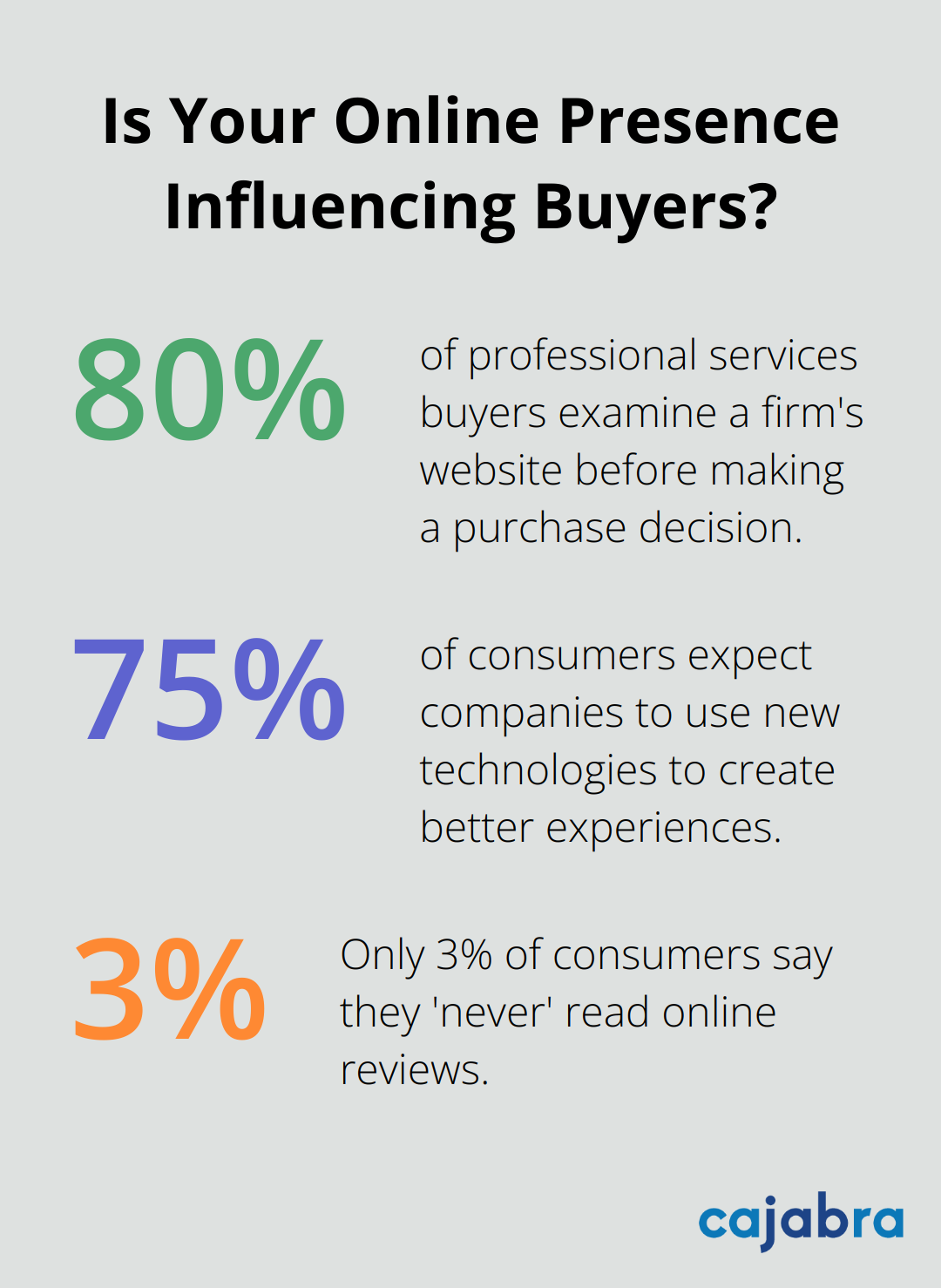
Your website also proves invaluable for client retention. It provides easy access to resources, client portals, and up-to-date information, which enhances client satisfaction and loyalty. A Salesforce survey found that 75% of consumers expect companies to use new technologies to create better experiences (a clear indication of the importance of a modern, user-friendly website).
Building Trust and Credibility
In the accounting world, trust reigns supreme. Your website offers a powerful platform to build that trust. You can establish credibility even before a potential client reaches out by showcasing your expertise through thought leadership content, client testimonials, and case studies.
A recent study found that only 3% of consumers say they 'never' read online reviews, reflecting how ingrained reviews are in most consumers' business research. For accounting firms, this translates to featuring client testimonials prominently on your website, which can significantly impact your perceived trustworthiness.
Differentiating in a Crowded Digital Landscape
With thousands of accounting firms competing for attention online, a generic website falls short. Your website must clearly communicate your unique value proposition and set your firm apart from competitors.
One effective strategy to stand out involves highlighting specialized services or niche expertise. For example, if your firm excels in tax planning for small businesses, your website should emphasize this focus throughout its content and design.
Data-Driven Continuous Improvement
A high-converting website evolves based on user behavior and performance data. Tools like Google Analytics provide valuable insights into how visitors interact with your site, allowing you to make data-driven improvements.
For instance, a high bounce rate on your services page might indicate that the content lacks engagement or the layout confuses visitors. Continuous analysis and optimization of your website can improve its performance and, ultimately, your conversion rates.
As we move forward, we'll explore the key elements that transform a good accounting website into a great one. These components work together to create a powerful online presence that not only attracts visitors but converts them into loyal clients.
Crafting a Website That Converts Clients
At the heart of every successful accounting firm's online presence lies a website that not only attracts visitors but also converts them into loyal clients. This chapter explores the key elements that transform a standard website into a powerful client-generating tool.
Communicate Your Unique Value
Your website's homepage must answer the question, "Why should potential clients choose your accounting firm?" A clear, concise, and compelling value proposition sets the tone for your entire online presence. Instead of generic statements, opt for specific, benefit-oriented messages. For example: "We help small businesses reduce tax liability by an average of 15%."
Design for User Experience
A Stanford University study found that 75% of users judge a company's credibility based on their website's design. Your site should captivate visitors visually and offer intuitive navigation. Implement a clean, professional design with a color scheme that aligns with your brand. Create a logical and easy-to-use menu structure. Users who can't find what they need within seconds will likely leave your site.
Showcase Your Expertise
Potential clients seek assurance that they're in capable hands. Your website should demonstrate your expertise through high-quality content. Consider including:
-
Blog posts about recent tax law changes
-
Downloadable guides on financial planning
-
Video tutorials on using accounting software

Companies that blog receive 97% more links to their website (according to HubSpot), which significantly boosts online visibility and perceived authority.
Leverage Social Proof
77% of consumers 'always' or 'regularly' read online reviews when browsing for local businesses. Your website should feature:
-
Client testimonials
-
Case studies
-
Relevant awards or certifications
These elements build trust and illustrate the real-world impact of your services. For instance, you could highlight a case study showing how you helped a local business save $50,000 in taxes through strategic planning.
Guide Visitors to Action
Every page on your website should serve a clear purpose and guide visitors towards taking action. Use prominent, strategically placed calls-to-action (CTAs) throughout your site. These could be buttons or links inviting visitors to:
-
"Schedule a Free Consultation"
-
"Download Our Tax Savings Guide"
-
"Get a Quote"
Ensure these CTAs stand out visually and use action-oriented language.
The elements discussed in this chapter form the foundation of a high-converting accounting website. However, creating a website is just the first step. The next chapter will explore how to optimize your site for maximum conversions, turning visitors into valuable clients.
Maximizing Website Conversions for Accounting Firms
Capture Leads with Irresistible Offers
Implement lead capture forms strategically throughout your website. These forms should offer something of value in exchange for contact information. Create a downloadable guide on "10 Tax-Saving Strategies for Small Businesses" or a free tax planning checklist. Place these offers on high-traffic pages and use compelling headlines to grab attention.
Research shows that eliminating just one field can increase conversions by a whopping 50%. Keep your forms short, ask only for essential information like name and email address. This approach will significantly increase your lead generation efforts.
Develop Content That Solves Client Problems
Create valuable content that addresses your target audience's pain points. This could include blog posts on recent tax law changes, video tutorials on bookkeeping best practices, or infographics explaining complex financial concepts.
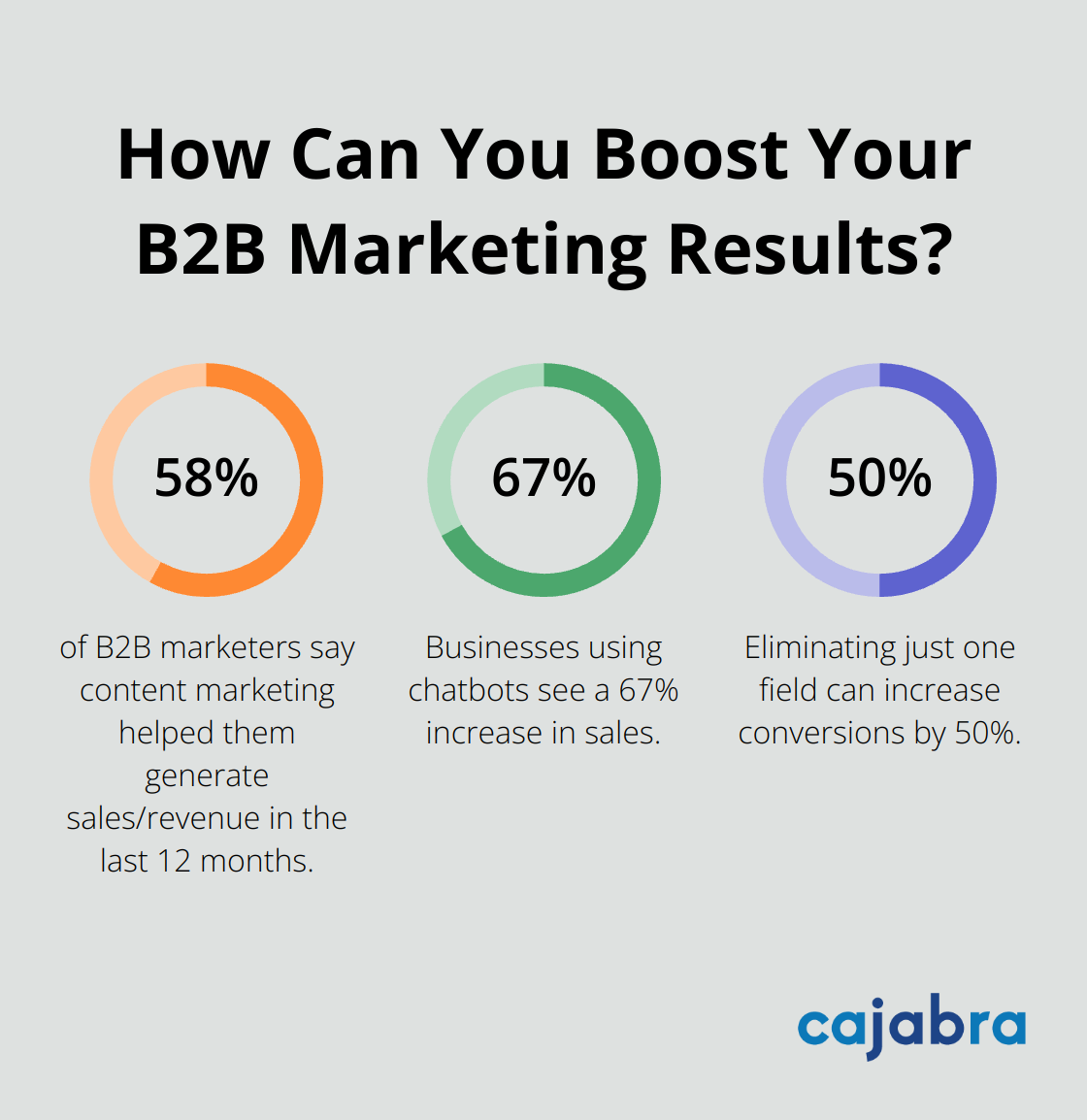
According to the Content Marketing Institute, 58% of B2B marketers say content marketing helped them generate sales/revenue in the last 12 months, up from 42% the previous year. Focus on creating in-depth, actionable content that showcases your expertise and provides real value to potential clients.
Leverage Technology for Instant Engagement
Implement chatbots on your website to provide instant responses to visitor inquiries. These AI-powered tools can answer common questions, schedule consultations, and even qualify leads 24/7. A study by Drift found that businesses using chatbots see a 67% increase in sales.
Program your chatbot with accurate information about your services, pricing, and availability. This immediate engagement can significantly improve user experience and increase the likelihood of conversion.
Optimize for Mobile Users
With over 50% of global web traffic coming from mobile devices (according to Statista), mobile optimization is no longer optional. Ensure your website is responsive and provides a seamless experience across all devices.
Pay special attention to mobile form design, button sizes, and page load times. Google's Mobile-Friendly Test tool can help identify areas for improvement in your mobile site design.
Accelerate Page Load Speed
Website speed directly impacts user experience and conversions. According to Google, as page load time increases from 1 to 3 seconds, the probability of bounce increases by 32%. Optimize your site's speed by:
- Compressing images without sacrificing quality
- Minimizing HTTP requests
- Leveraging browser caching
- Using a content delivery network (CDN)
Tools like Google's PageSpeed Insights can provide specific recommendations for improving your site's load time.
Final Thoughts
Creating a high-converting website for your accounting firm requires ongoing refinement and optimization. We explored essential elements that make accounting consulting websites effective client-conversion tools. These components attract and retain clients through clear value propositions, user-friendly designs, compelling content, and strategic CTAs.
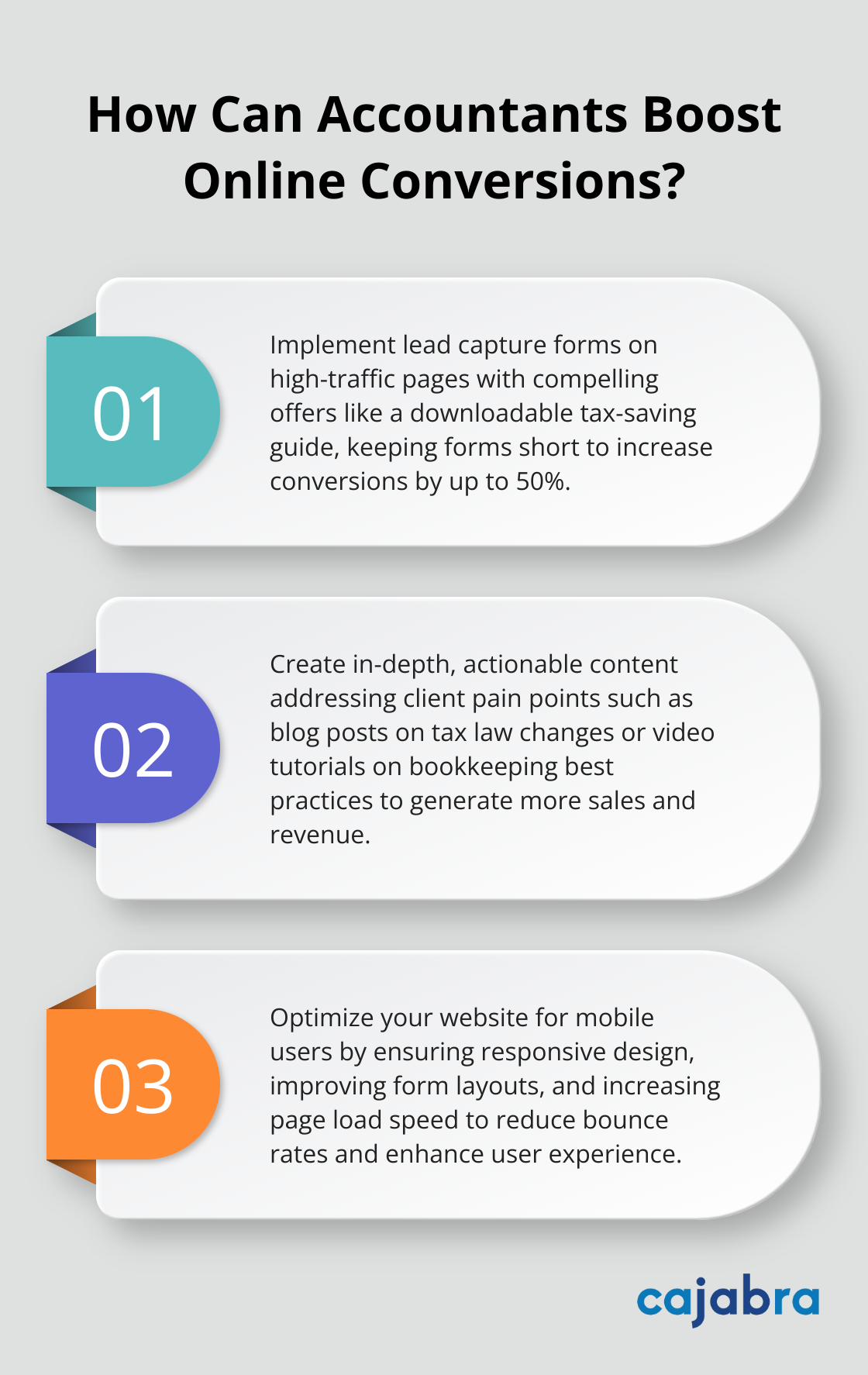
Your website reflects your expertise and builds trust as the digital face of your accounting firm. It guides potential clients to take action through lead capture forms, valuable content, chatbots, mobile optimization, and improved page load speeds. The digital landscape evolves constantly, necessitating regular testing, analysis, and improvements based on user behavior and industry trends.
At Cajabra, we help accounting firms create and optimize websites that convert visitors into loyal clients. Our JAB System™ moves accountants from overlooked to overbooked in 90 days. We offer comprehensive solutions, including website modernization and digital footprint optimization. Partner with Cajabra to focus on your expertise while we handle your online presence and marketing efforts.
In today's crowded marketplace, standing out is harder than ever. At Cajabra, LLC, we know that a creative messaging strategy is the key to capturing your audience's attention and building lasting connections.
Brand storytelling goes beyond mere marketing; it's about crafting a narrative that resonates with your customers on a deeper level. This blog post will explore how to create compelling brand stories that not only differentiate your business but also foster trust and loyalty among your target audience.
Why Brand Stories Matter
Brand stories are not just marketing fluff; they are powerful tools that transform businesses. At their core, brand stories create deep connections with customers, helping companies stand out in a sea of competitors.
Forging Emotional Bonds
People don't buy products; they buy into stories. A study by Headstream revealed that if people love a brand story, 55% are more likely to buy the product in the future. This statistic underscores the importance of narratives that resonate with your audience on an emotional level.

To create these emotional bonds, companies should focus on shared values and experiences. Patagonia's brand story, for example, centers on environmental activism, attracting customers who share their passion for conservation. When a brand aligns its story with customers' values, it creates a sense of belonging that transcends mere transactions.
Standing Out in a Crowded Market
In today's saturated markets, a unique brand story can become a secret weapon. An Edelman report found that nearly two-thirds (64 percent) of consumers around the world will buy or boycott a brand solely because of its position on a social or political issue. This demonstrates that a well-crafted brand story can significantly differentiate a company.
Companies should identify what makes their brand truly unique to leverage this advantage. Is it the origin story? The mission? The approach to customer service? Once pinpointed, this unique aspect should weave into every facet of brand communication.
Building Trust and Fostering Loyalty
Trust forms the foundation of any lasting relationship, including those between brands and customers. A compelling brand story builds this trust by showcasing a company's values, mission, and authenticity.
The 2019 Edelman Trust Barometer Special Report revealed that 81% of consumers need to trust a brand before they'll buy from them. Sharing a brand's journey (including both successes and challenges) creates transparency that fosters trust.
Moreover, when customers trust a brand, they're more likely to become loyal advocates. A study by Motista found that customers with an emotional connection to a brand have a 306% higher lifetime value and stay with a brand for an average of 5.1 years (vs 3.4 years for those without such a connection).
As we move forward, it's clear that brand stories play a pivotal role in shaping customer perceptions and driving business success. The next section will explore the key elements that make these stories truly effective.
What Makes Brand Stories Stick?
The Power of Authenticity
Authenticity forms the foundation of any compelling brand story. In an era where consumers face a barrage of marketing messages, they've honed their ability to detect insincerity. A Stackla study revealed that 88% of consumers consider authenticity important when deciding which brands to like and support, with 50% saying it's very important.
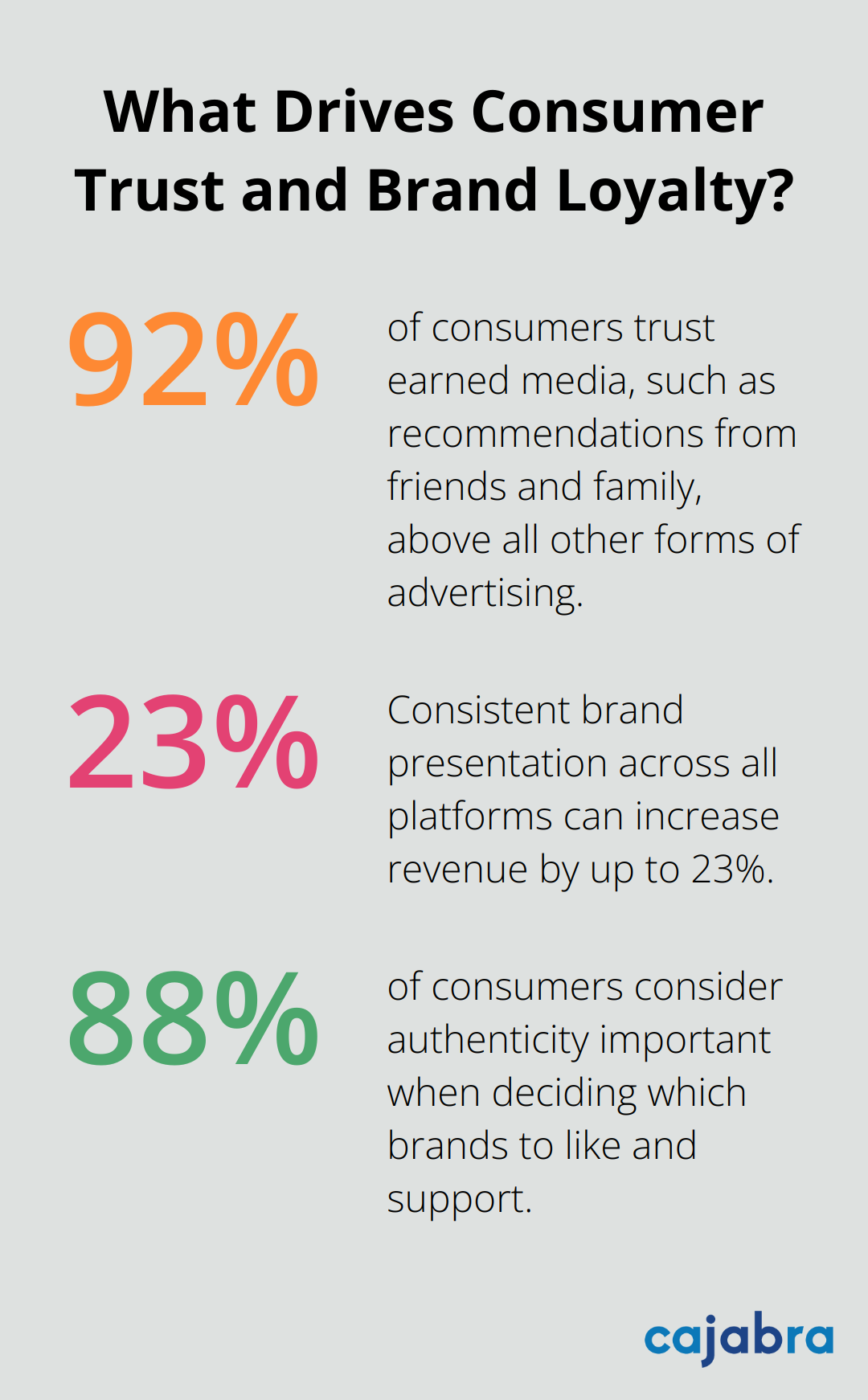
To achieve authenticity, brands must embrace transparency about their journey. This includes sharing both triumphs and setbacks. Airbnb, for instance, openly discusses how they overcame early challenges, which humanizes their brand and builds trust with their audience.
Aligning Values with Mission
Clear brand values and a well-defined mission prove essential for creating a story that resonates. The 2018 Edelman Earned Brand study found that 64% of consumers choose, switch, avoid or boycott a brand based on its stance on societal issues.
Patagonia exemplifies this alignment. Their mission to "build the best product, cause no unnecessary harm, use business to inspire and implement solutions to the environmental crisis" permeates every aspect of their brand story. This clear connection between values and mission has earned them a fiercely loyal customer base.
Consistency Across Touchpoints
A brand story loses its impact if it lacks consistency across all platforms and touchpoints. A Lucidpress study indicates that consistent brand presentation across all platforms can increase revenue by up to 23%.
This consistency requires that your brand story reflects in everything from your website and social media to your customer service interactions and product packaging. Starbucks excels at this, maintaining a consistent narrative of creating a "third place" between work and home across all their touchpoints.
The Human Element
Effective brand stories often feature relatable characters or personas (which could be founders, employees, or even customers). A Nielsen study found that 92% of consumers trust earned media, such as recommendations from friends and family, above all other forms of advertising.
Dollar Shave Club masterfully used their founder as a relatable character in their viral launch video, which helped catapult the brand to success. By putting a face to the brand, they created an immediate connection with their audience.
As we move forward, we'll explore specific techniques that can help you craft these compelling brand messages, turning your story into a powerful tool for customer engagement and business growth.
How to Craft Messages That Resonate
Harness the Power of Storytelling
Stories captivate humans for millennia, and they remain powerful in modern marketing. Structure your brand message like a story, with a clear beginning, middle, and end. Identify your brand's origin story or core mission. Highlight the challenges you've faced and overcome. Showcase how your solutions benefit customers.
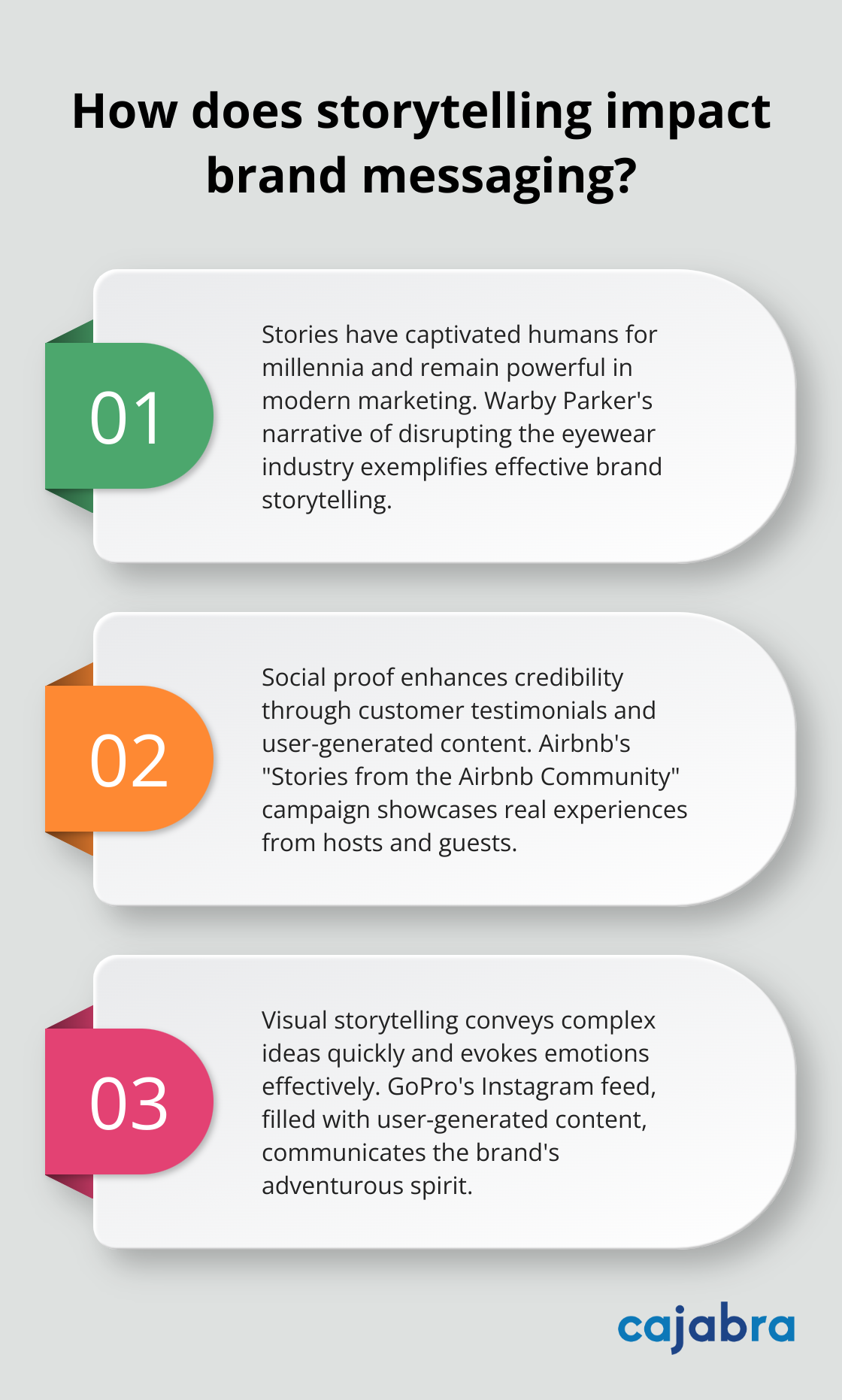
Warby Parker's story of disrupting the eyewear industry by offering affordable, stylish glasses directly to consumers exemplifies this approach. This narrative explains their business model and positions them as innovators and problem-solvers.
Leverage Social Proof
The voices of satisfied customers speak louder than any marketing claim. Incorporate customer testimonials and user-generated content into your brand messaging to boost credibility and trust.
Ask your happy clients to share their experiences. Feature these testimonials prominently on your website, social media, and marketing materials. Airbnb's "Stories from the Airbnb Community" campaign showcases real experiences from hosts and guests, adding authenticity to their brand message.
Embrace Visual Storytelling
In our increasingly visual digital world, images and videos serve as powerful tools for brand messaging. Visual content conveys complex ideas quickly and evokes emotions more effectively than text alone.
Create infographics to present data in an engaging way. Develop short videos that showcase your products or services in action. Use high-quality images that reflect your brand's personality and values. GoPro's Instagram feed (filled with user-generated content showing their cameras in action) effectively communicates the brand's adventurous spirit.
Back Your Claims with Data
While emotional connections matter, don't underestimate the power of hard facts. Incorporate relevant data and statistics into your brand messaging to lend credibility to your claims and help you stand out as an authority in your field.
When discussing marketing services, don't just say they work - highlight specific outcomes. For example, Cajabra's JAB System™ moves accountants from overlooked to overbooked in just 90 days. This specific timeframe gives potential clients a concrete expectation and demonstrates confidence in the system's effectiveness.
Always cite your sources when using external data. This transparency enhances your credibility and allows interested parties to verify the information.
Tailor Your Message to Your Audience
Understand your target audience's needs, pain points, and preferences. Craft messages that directly address these aspects. Use language and tone that resonates with your specific audience.
For instance, if you target small business owners, focus on how your product or service saves time and money (two precious resources for this demographic). If you aim at millennials, emphasize sustainability and social responsibility in your messaging.
Final Thoughts
Creative messaging strategies form the core of successful brands in today's competitive marketplace. We explored the power of brand storytelling, its key elements, and techniques for crafting compelling messages. Authenticity, emotional connection, and consistency play vital roles in developing your brand's narrative.
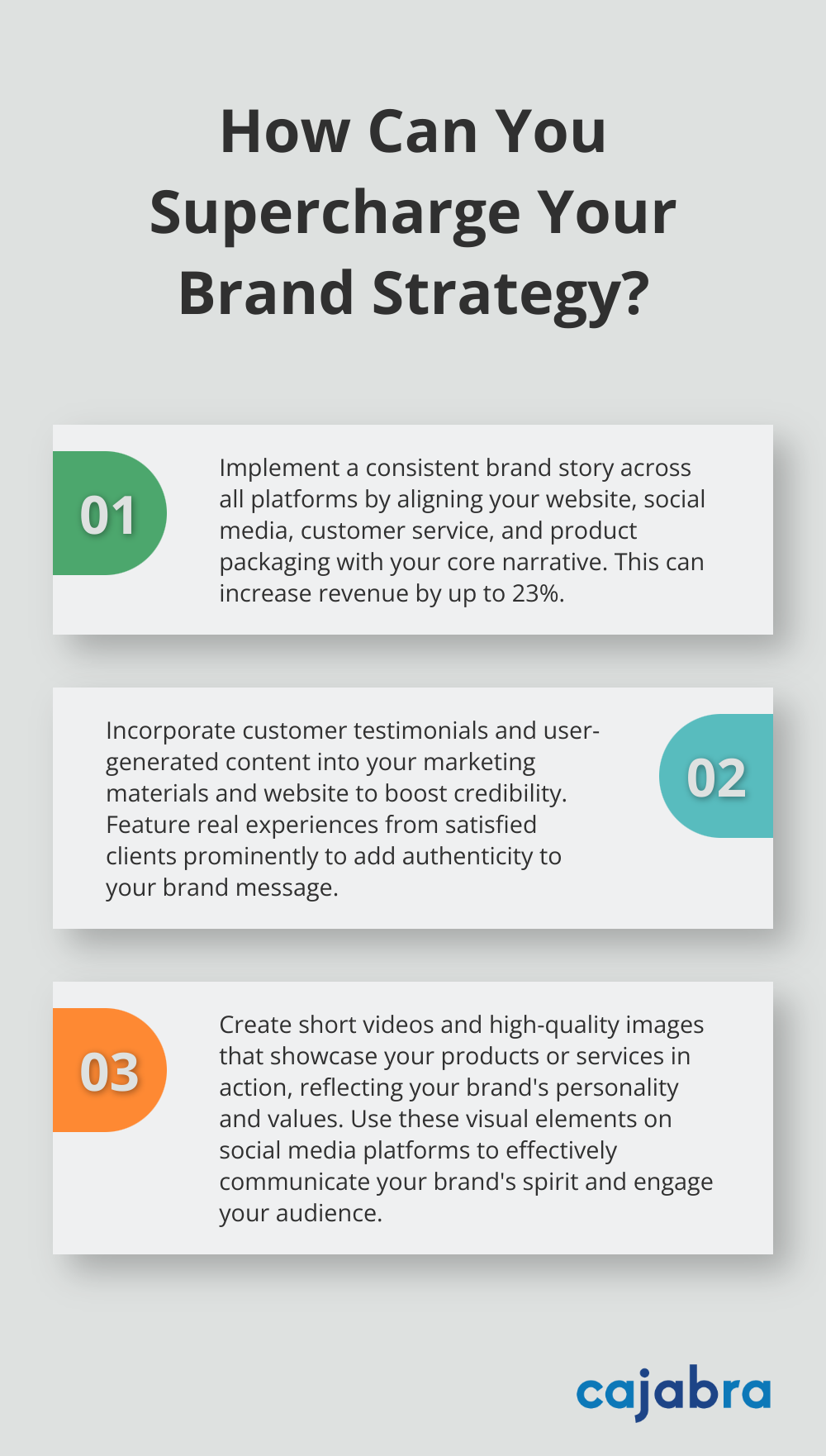
Take a fresh look at your own brand story and identify what makes your company unique. Communicate your values and mission in a way that resonates with your target audience. A well-crafted brand story will differentiate you from competitors, build trust with customers, and foster long-term loyalty.
At Cajabra, we help accounting firms develop powerful brand stories and marketing strategies. Our JAB System™ moves accountants from overlooked to overbooked in 90 days (securing retainer-based clients and maximizing revenue). We offer tailored solutions to enhance your online presence and position your firm as an industry leader.
At Cajabra, LLC, we know that a strong messaging strategy is the backbone of effective communication with your audience.
A well-crafted messaging strategy template can help you align your brand's voice, values, and offerings with your customers' needs and expectations.
In this post, we'll guide you through the essential steps to create a powerful messaging strategy that resonates with your target audience and drives results.
Who Is Your Target Audience?
Conduct Thorough Market Research
Understanding your target audience forms the foundation of any successful messaging strategy. Start by collecting data on your potential customers. Use Google Analytics to understand website visitors and their content engagement. Social media analytics provide valuable insights into follower demographics and interests. Analyze your competitors' audiences to reveal untapped market segments.

A recent study found that companies that meet or exceed revenue targets are 2.4 times more likely to use personas effectively than those that miss their targets. This statistic highlights the importance of thorough market research in driving business success.
Create Detailed Buyer Personas
After data collection, bring your ideal customers to life through buyer personas. These detailed profiles extend beyond basic demographics to include psychographics, behavior patterns, and motivations.
For example, a small business owner persona might include:
-
Age range: 35-50
-
Education: Bachelor's degree in business (or related field)
-
Pain points: Time management and financial planning challenges
-
Goals: 20% business revenue growth in the next year
-
Preferred communication channels: Email and LinkedIn
Create multiple personas if you target different segments. The more specific you are, the more effectively you can tailor your messaging.
Identify Key Pain Points and Desires
To create resonant messaging, understand what keeps your audience awake at night and what they aspire to achieve. Conduct surveys, interviews, or focus groups with existing clients or potential customers to uncover these insights.
Ask questions such as:
-
What's the biggest challenge you face in your business right now?
-
If you had a magic wand, what one thing would you change about your current situation?
-
What does success look like for you in the next 1-3 years?
These questions can reveal valuable information to inform your messaging strategy. For instance, if many target customers express frustration with complex accounting software, highlight how your services simplify financial management in your messaging.
This deep understanding of your target audience sets the stage for crafting a core message that truly resonates with your ideal customers. The next step involves translating these insights into a compelling value proposition and brand story that speaks directly to your audience's needs and aspirations.
How to Craft a Core Message That Resonates
Define Your Unique Value Proposition
Your unique value proposition (UVP) forms the cornerstone of your messaging strategy. It distinguishes you from competitors and addresses your clients' needs directly. For accounting firms, this could involve specialized industry expertise, innovative technology use, or exceptional customer service.

To develop your UVP:
- List your firm's strengths
- Compare them to your competitors
- Align these strengths with your target audience's pain points and desires
For example, if small business owners struggle with time management, your UVP might highlight how your AI-powered tools can enhance efficiency in financial tasks.
Develop a Compelling Brand Story
Stories connect with people more effectively than facts and figures alone. Your brand story should intertwine your firm's history, values, and mission in a way that emotionally resonates with your audience. A study found that 92% of consumers want brands to make ads feel like a story.
When you craft your brand story, focus on the 'why' behind your firm:
-
Why did you start your accounting practice?
-
What motivates you to help your clients succeed?
Include specific examples of how you've helped clients overcome challenges. You might share how you helped a local restaurant chain reduce their tax liability by 30% through strategic planning, enabling them to open two new locations.
Create a Consistent Tone and Voice
Your brand's tone and voice should reflect your firm's personality and appeal to your target audience. The key lies in consistency across all communication channels.
If your target audience consists of young entrepreneurs, a more casual and tech-savvy tone might work well. You could use phrases like "Let's crunch those numbers" instead of "We'll perform a financial analysis."
To maintain consistency:
- Create a brand voice guide
- Outline your firm's personality traits
- List preferred language and taboo words or phrases
- Share this guide with everyone involved in content creation
Refine Your Message Regularly
Your core message isn't permanent. As your firm evolves and market conditions change, you should refine your message. Solicit feedback from clients and team members regularly to ensure your message continues to resonate and accurately represent your firm's value.
The next step in creating a powerful messaging strategy involves developing a message hierarchy and selecting the right channels to reach your audience effectively. This process ensures that your carefully crafted core message reaches the right people through the most impactful platforms.
By embracing accounting market automation, you can boost your firm's efficiency and transform your marketing efforts, allowing you to focus more on crafting and delivering your core message effectively.
How to Reach Your Audience Effectively
Prioritize Your Key Messages
Not all messages carry equal weight. Some resonate more strongly with certain segments of your audience. To maximize impact, rank your messages based on their importance to different audience segments. For example, if you target both small business owners and corporate CFOs, your messaging priorities will differ for each group.
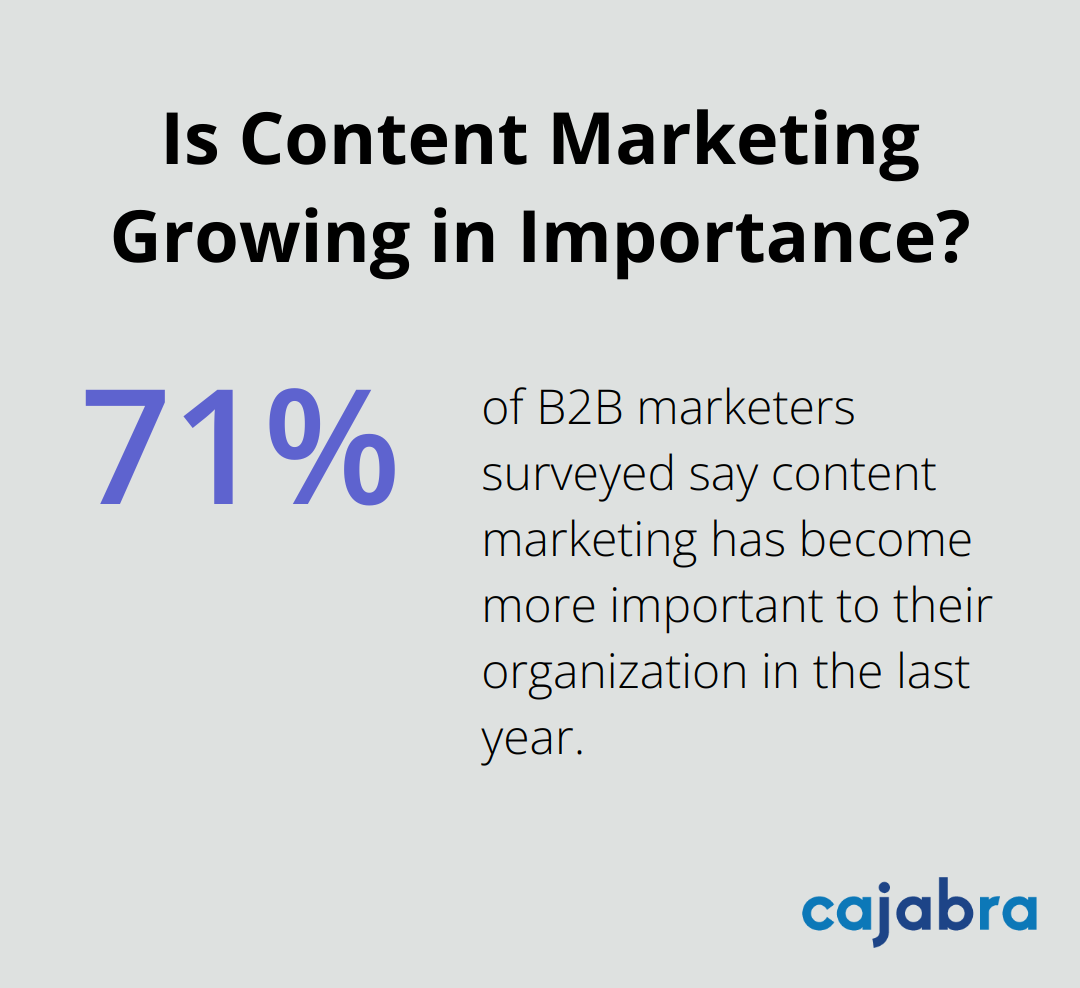
Small business owners might respond better to messages about cost-effective solutions and time-saving tools. CFOs, on the other hand, might prioritize messages focusing on advanced analytics capabilities and regulatory compliance expertise. Align your messages with each segment's specific needs and pain points to increase engagement and conversion rates.
Select the Right Communication Channels
The choice of channels to distribute your message is as important as the message itself. Different audience segments prefer different platforms, and it's essential to meet them where they are.
71% of B2B marketers surveyed say content marketing has become more important to their organization in the last year. However, if your target audience includes younger entrepreneurs, platforms like Instagram or TikTok might prove more effective.
Email marketing remains a powerful tool, with an average ROI of $36 for every $1 spent. The key is to use it strategically. Segment your email list based on client type, engagement level, and interests to ensure your messages are relevant and timely.
Tailor Your Content for Each Platform
After selecting your channels, adapt your content for each platform. What works on LinkedIn might not be effective on Instagram or in an email newsletter.
For LinkedIn, focus on professional insights and industry trends. Share detailed case studies or thought leadership articles that showcase your expertise. On Instagram, use visually appealing infographics or short video clips to convey key financial concepts or tips.
When it comes to email marketing, personalization is key. Use data from your CRM to tailor content based on the recipient's industry, company size, or past interactions with your firm. This level of customization can significantly boost engagement rates.
Maintain consistency in your core message and brand voice across all platforms. While the format and style may change, the underlying message should remain cohesive.
Analyze and Adjust Your Strategy
Implement these strategies to ensure your carefully crafted messages reach and resonate with your target audience, driving engagement and ultimately, business growth. Continually analyze your results and adjust your tactics based on what works best for your firm.
Try A/B testing different message variations or channel strategies to optimize your approach. Use analytics tools (such as Google Analytics or social media insights) to track engagement metrics and refine your messaging strategy over time.
Final Thoughts
A powerful messaging strategy template requires a deep understanding of your target audience and a well-crafted core message. You must conduct thorough market research, develop detailed buyer personas, and identify key pain points to create a strategy that resonates with your audience. Your unique value proposition, compelling brand story, and consistent tone will set you apart from competitors and strengthen your message.
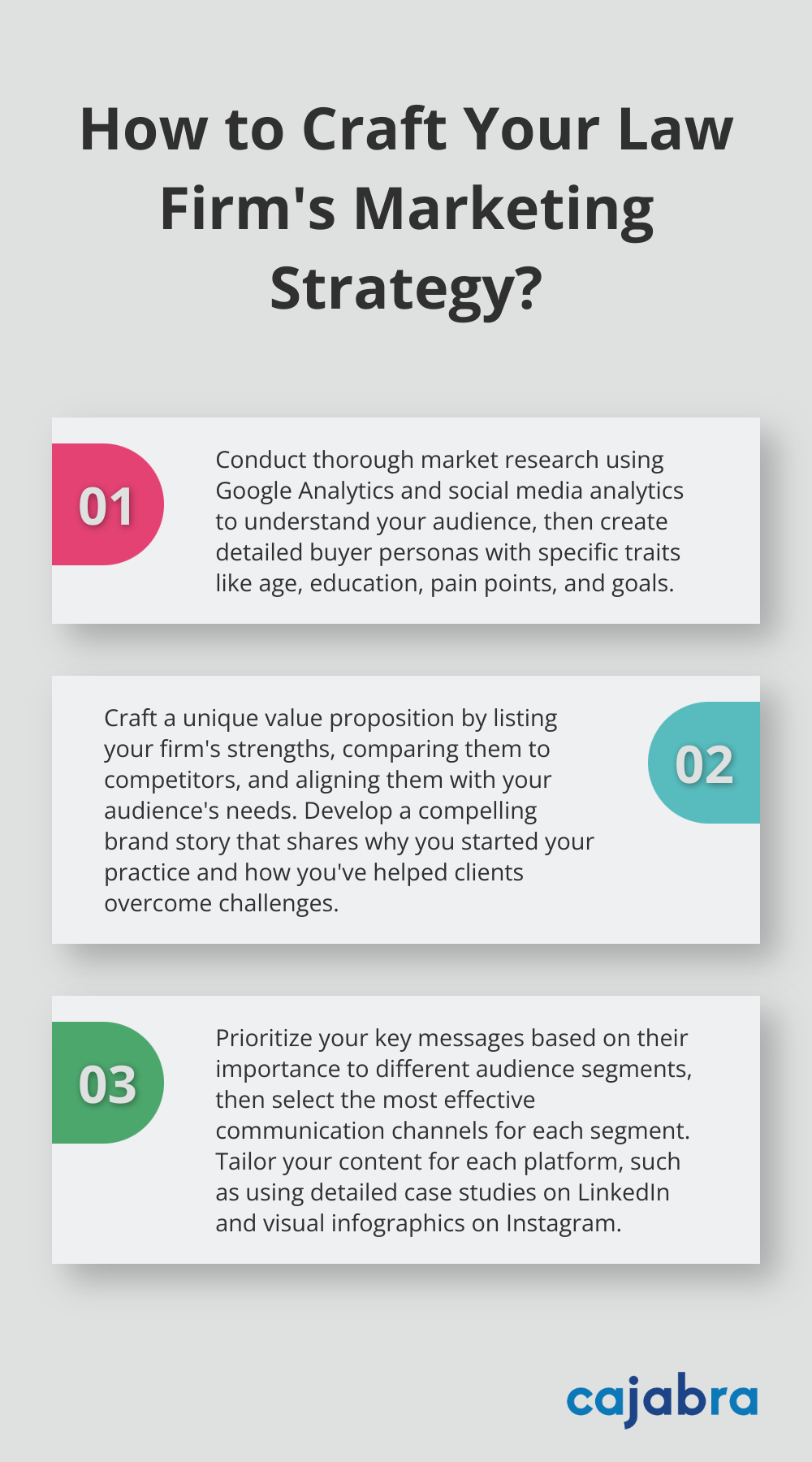
Selecting appropriate communication channels and tailoring content for each platform will ensure your message reaches the right people effectively. You should prioritize key messages for different segments and adapt your content to suit various platforms. A messaging strategy is not a one-time effort but an ongoing process that requires regular refinement to stay relevant in a constantly evolving market.
At Cajabra, we understand the challenges accounting firms face in creating and implementing effective messaging strategies. Our specialized marketing services for accountants will help you develop a powerful messaging strategy template that aligns with your firm's unique value proposition and resonates with your target audience. We handle all aspects of marketing, allowing you to focus on serving your clients.
In today's digital landscape, accounting practice websites are no longer optional-they're essential. At Cajabra, LLC, we've seen firsthand how a well-crafted online presence can transform an accounting firm's success.
A professional website not only showcases your expertise but also serves as a powerful tool for attracting and converting potential clients. In this post, we'll explore the key elements that make accounting websites truly impactful and share practical strategies to help your firm stand out in the competitive digital marketplace.
Why Your Online Presence Matters
The Power of First Impressions
In the digital age, your accounting firm's website often serves as the initial point of contact with potential clients. A strong online presence isn't just a luxury-it's a necessity for attracting and retaining clients in a competitive market.

Research indicates that visual appeal can be assessed within 50 milliseconds. This split-second judgment can determine whether a visitor becomes a client. A professional, well-designed website immediately communicates competence and reliability (two qualities clients prioritize when selecting an accountant).
Building Trust Through Your Website
Your website functions as a digital storefront, showcasing your expertise and services around the clock. A study by Stanford University revealed that 75% of users make judgments about a company's credibility based on their website design. When you present clear, valuable information and a user-friendly interface, you don't just inform visitors-you establish trust.
Attracting New Clients in the Digital Marketplace
The internet has transformed how people search for services, including accounting. A BrightLocal survey found that 91% of consumers say local branch reviews impact their overall perceptions of big brands in some way. Without a strong online presence, you miss out on a significant portion of potential clients who actively seek accounting services.
Some accounting firms have increased their client base by up to 40% within six months of launching an optimized website. This growth doesn't stem from merely having a website-it results from having the right website that effectively communicates your value proposition and guides potential clients towards action.
Leveraging Your Online Presence for Growth
Your online presence extends beyond a digital business card. It serves as a powerful tool for growth, credibility, and client acquisition. A well-crafted website can:
- Showcase your expertise through informative blog posts and case studies
- Provide easy access to your services and pricing information
- Offer convenient ways for potential clients to contact you or schedule consultations
The Role of SEO in Online Visibility
Search Engine Optimization (SEO) plays a vital role in ensuring your website reaches your target audience. By optimizing your site for relevant keywords and local searches, you increase your chances of appearing in search results when potential clients look for accounting services in your area.
As we move forward, we'll explore the key elements that make an accounting website truly effective in converting visitors into clients. These components work together to create a powerful online presence that sets your firm apart in the digital landscape.
marketing automation solutions can significantly enhance your online presence, helping you attract and engage potential clients more effectively.
What Makes an Accounting Website Effective?
Speak Directly to Your Audience
Your website must address the needs and pain points of your potential clients immediately. Use clear, jargon-free language that connects with your target audience. Instead of simply listing tax preparation services, highlight how you save clients time and reduce their stress during tax season.
A study by Nielsen Norman Group found that web users spend 80% of their time looking at information above the page fold. Make those seconds count by clearly communicating your unique value proposition above the fold on your homepage.
Design for User Experience
User-friendly navigation keeps potential clients engaged on your site. Implement a logical menu structure that allows visitors to find the information they need in three clicks or less. A Forrester Research study showed that a well-designed user interface can raise your website's conversion rate by up to 200%.
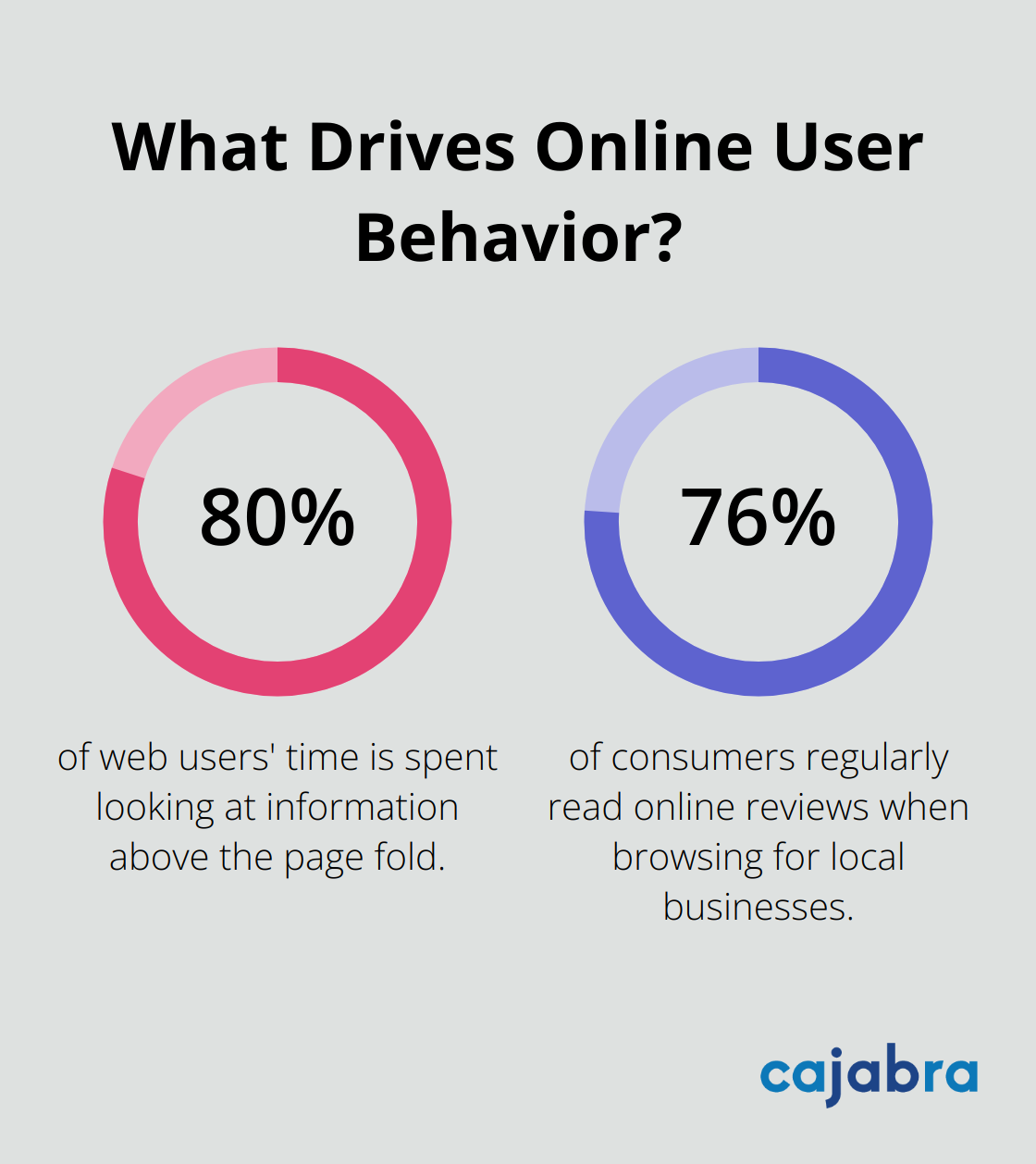
Use a sticky navigation bar that remains visible as users scroll, making it easy for them to access key pages at any time. This simple design element can significantly improve user experience and keep potential clients on your site longer.
Showcase Your Expertise
Demonstrating your expertise builds trust with potential clients. Include a dedicated page for your services, detailing how each offering addresses specific client needs. Case studies and client success stories provide concrete examples of your impact, making your expertise tangible to prospects.
Client testimonials are particularly powerful. According to BrightLocal, 76% of consumers regularly read online reviews when browsing for local businesses. Feature these testimonials prominently on your homepage and service pages to build credibility.
Drive Action with Strategic CTAs
Effective call-to-action (CTA) buttons convert website visitors into leads. Use action-oriented language that creates a sense of urgency, such as "Get Your Free Consultation Now" or "Start Saving on Taxes Today".
Place CTAs strategically throughout your site, especially after sections that highlight your expertise or client success stories. A/B testing different CTA placements and wording can help you optimize for conversions. HubSpot reports that personalized CTAs convert 202% better than default versions.
Optimize for Mobile Users
In today's mobile-first world, your accounting website must perform flawlessly on smartphones and tablets. Google's mobile-first indexing means that the mobile version of your site determines your search engine rankings. Ensure your site uses responsive design (adapting to different screen sizes) and loads quickly on mobile devices.
A mobile-optimized site not only improves user experience but also boosts your search engine visibility. This increased visibility can lead to more potential clients finding and engaging with your accounting services.
As we move forward, we'll explore how to leverage search engine optimization (SEO) to further enhance your accounting website's visibility and effectiveness in attracting potential clients.
Implement Marketing Automation
Marketing automation solutions can significantly enhance the effectiveness of your accounting website. These tools can help you create lead-generating websites and sales funnels, allowing you to build your business without feeling overwhelmed. By automating repetitive tasks and nurturing leads, you can focus more on providing quality accounting services to your clients.
How to Boost Your Accounting Website's Search Engine Visibility
Search engine optimization (SEO) transforms accounting websites. Proper SEO increases visibility and client acquisition for accounting firms significantly.
Master Your Keyword Strategy
Thorough keyword research forms the foundation of effective SEO. Focus on long-tail keywords that potential clients use when searching for accounting services. Instead of targeting broad terms like "accountant," try specific phrases such as "small business tax accountant in [your city]." Tools like SEMrush or Ahrefs help identify these valuable keywords.
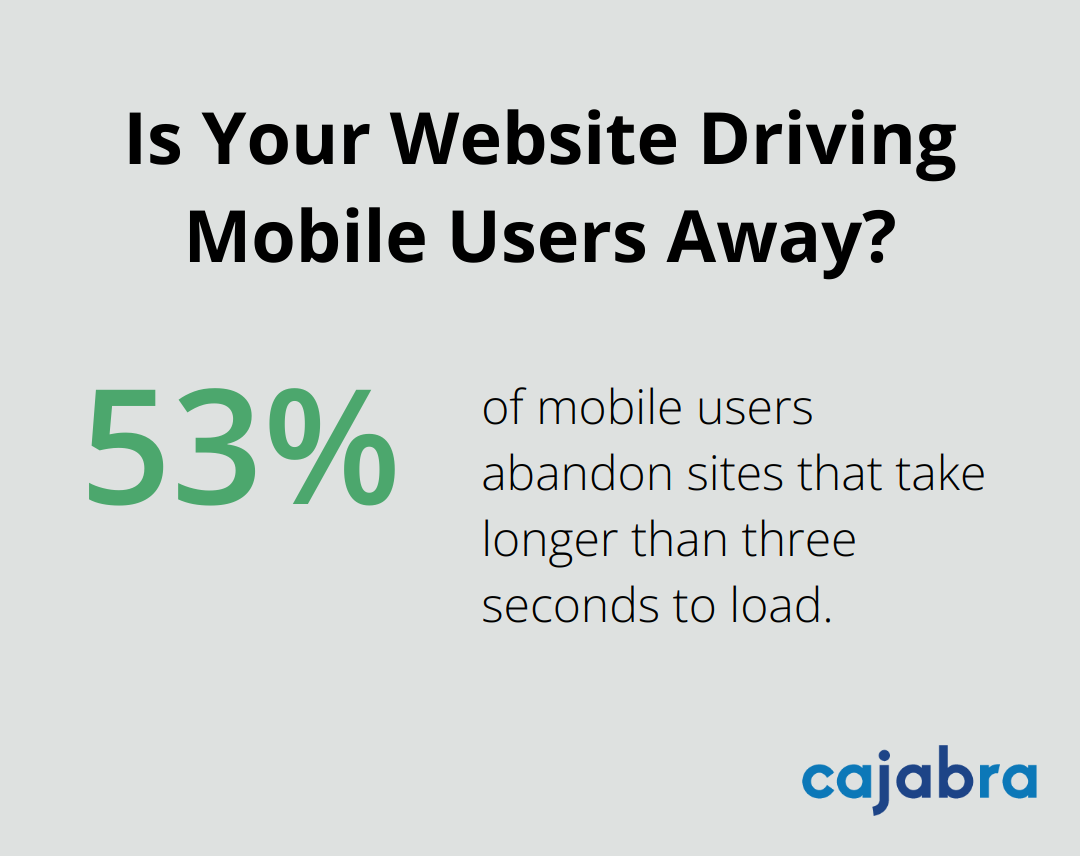
Strategically incorporate your target keywords into your website's content, meta descriptions, and title tags. However, avoid keyword stuffing – search engines penalize this practice. Try natural language that provides value to your readers.
Create Content That Converts
High-quality, industry-specific content drives SEO for accounting websites. Publish blog posts, articles, and guides that address common financial concerns and questions your potential clients have regularly. This improves your search rankings and positions your firm as an authority in the field.
During tax season, create content around topics like "Top 10 Tax Deductions for Small Businesses" or "How Recent Tax Law Changes Affect Your Filing." Make these pieces informative, actionable, and optimized for your target keywords.
Dominate Local Search Results
Local SEO proves crucial for accounting firms. Local searches contribute 22.6% of website traffic. To capitalize on this:
- Claim and optimize your Google My Business listing
- Ensure your NAP (Name, Address, Phone number) stays consistent across all online directories
- Encourage satisfied clients to leave reviews on Google and other platforms
- Create location-specific pages on your website for each area you serve
These strategies can significantly boost your visibility in local search results, driving more qualified leads to your firm.
Leverage Technical SEO
While content reigns supreme, technical SEO forms the foundation that supports it. Ensure your website loads quickly – Google states that 53% of mobile users abandon sites that take longer than three seconds to load. Use tools like Google's PageSpeed Insights to identify and fix speed issues.
Implement a secure HTTPS protocol (now a ranking factor for Google). Also, make your website mobile-friendly, as Google primarily uses the mobile version of content for ranking and indexing.
Structured data markup (such as Schema.org) helps search engines better understand your content and potentially improves your search listings with rich snippets.
Utilize Marketing Automation
Marketing automation enhances the effectiveness of your accounting website. These tools create lead-generating websites and sales funnels, allowing you to build your business without feeling overwhelmed. Automation of repetitive tasks and lead nurturing lets you focus more on providing quality accounting services to your clients.
For marketing automation solutions tailored for accounting firms, Cajabra Marketing offers specialized services. They help accountants improve their marketing strategies for accounting firms.
Establish Thought Leadership
Thought leadership plays an essential role in molding your professional reputation online and improving your visibility on search engines. By consistently producing high-quality, insightful content in your field, you can establish yourself as an authority in the accounting industry. This not only attracts potential clients but also improves your website's search engine rankings.
Final Thoughts
Accounting practice websites serve as powerful tools for growth and client acquisition. A professional, user-friendly site effectively communicates your value proposition and can significantly increase your client base and revenue. It showcases your expertise and services to potential clients 24/7, even when you're not actively working.

We at Cajabra specialize in helping accounting firms create impactful websites and implement effective marketing strategies. Our JAB System™ aims to move accountants from overlooked to overbooked in 90 days by securing retainer-based clients. We handle marketing aspects, allowing you to focus on providing excellent accounting services.
A strong online presence builds a foundation for sustainable growth and success in the competitive accounting world. Take the first step today and watch your practice thrive in the digital age. Your website often provides the first impression for potential clients, so ensure it accurately represents your expertise and professionalism.
At Cajabra, LLC, we know that a well-designed website is essential for accounting firms to attract and retain clients in today's digital landscape.
Effective accounting websites design goes beyond aesthetics; it's about creating a powerful online presence that showcases your expertise and converts visitors into clients.
In this post, we'll explore the key elements of successful accounting websites and provide practical tips to optimize your online platform for both search engines and user experience.
What Makes an Accounting Website Successful?
A successful accounting website serves as a powerful tool to attract new clients, showcase expertise, and differentiate your firm from competitors. Several key elements contribute to an effective accounting website.
Design That Speaks Volumes
First impressions matter, especially in the accounting world. A clean, professional design instantly communicates credibility and attention to detail. Choose a color scheme that aligns with your brand and conveys trust – blues and greens often work well in the financial sector. Use high-quality images (preferably custom photography of your team and office) to add a personal touch.
Navigation That Guides Clients
Your website should mirror the organization of your financial statements. Implement a logical menu structure that allows visitors to find information quickly. Use a sticky header that remains visible as users scroll, ensuring easy access to key pages like Services, About Us, and Contact. A study by the Nielsen Norman Group found that users spend 80% of their time above the fold, so prioritize your most important information at the top of each page.
Expertise on Display
Showcase your services and expertise prominently. Create dedicated pages for each service you offer, providing detailed information and the benefits clients can expect. Include case studies that demonstrate real-world results (e.g., how you helped a small business save $50,000 in taxes through strategic planning). These concrete examples prove more compelling than generic service descriptions.
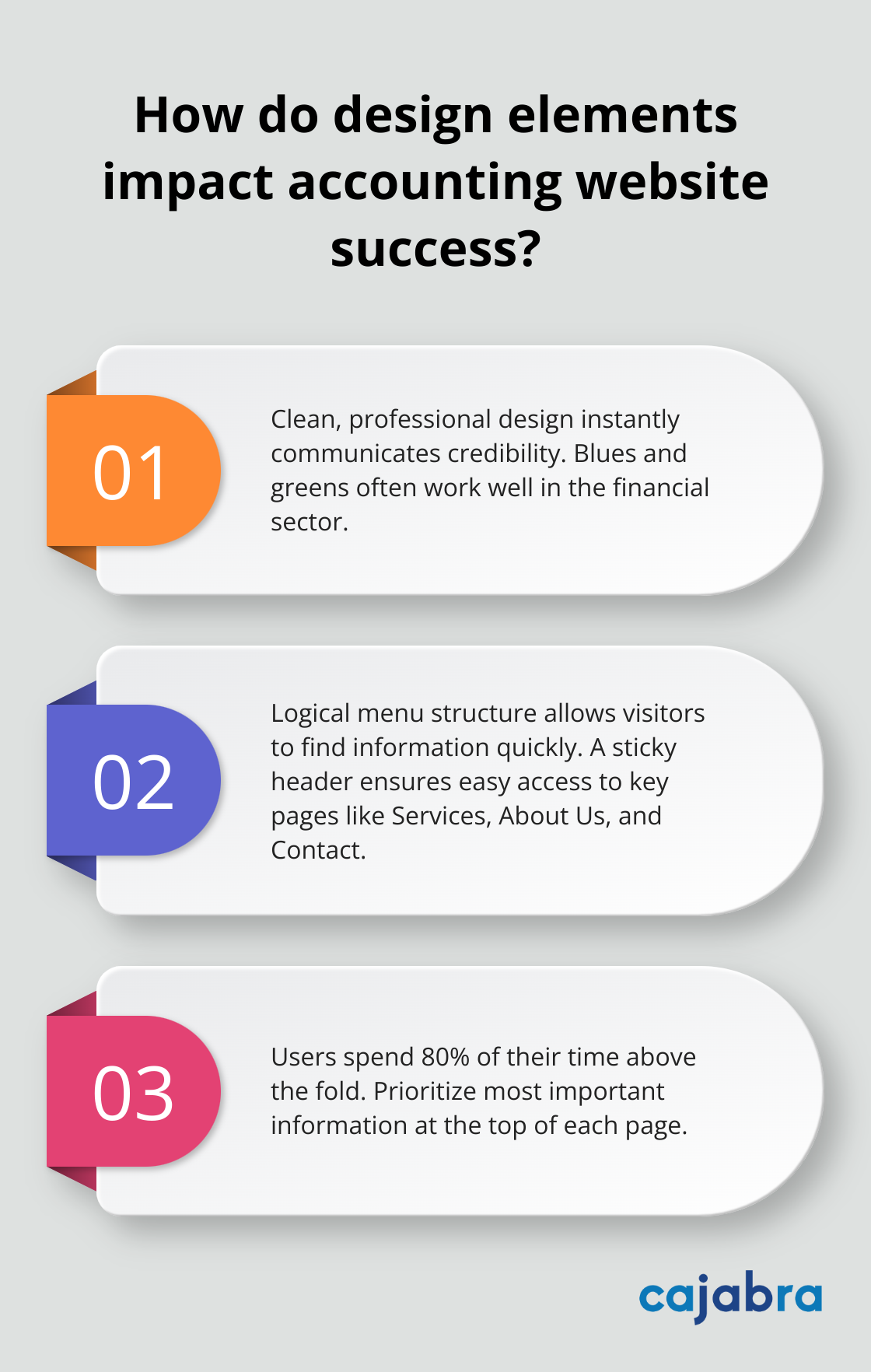
Highlight any industry-specific certifications or awards your firm has received. This builds credibility and sets you apart from competitors who may lack these accolades.
Social Proof Seals the Deal
Client testimonials and case studies build trust effectively. BrightLocal's Local Consumer Review Survey revealed that 87% of consumers read online reviews for local businesses in 2020. Feature testimonials prominently on your homepage and create a dedicated testimonials page. Include the client's name, photo, and company (with permission) to add authenticity.
Calls-to-Action That Convert
Every page on your website should guide visitors towards taking action. Use clear, compelling calls-to-action (CTAs) that stand out visually and use action-oriented language. For example, replace a generic "Contact Us" button with "Schedule Your Free Tax Consultation." Place CTAs strategically throughout your site, especially after sections that highlight your expertise or client success stories.
These elements form the foundation of a powerful online presence for accounting firms. However, a great website doesn't stop at design and content. The next chapter will explore how to optimize your site for search engines and user experience, ensuring that potential clients not only find your website but also have a seamless experience once they arrive.
How to Optimize Your Accounting Website for Search and Users
At Cajabra, LLC, we understand that creating a great website is only half the battle. To truly succeed online, your accounting firm's website needs to be discoverable by potential clients and provide an exceptional user experience. Here's how to achieve both:
Master Your Keyword Strategy
Start by identifying the specific terms your ideal clients use when searching for accounting services. Tools like Google Keyword Planner or SEMrush can reveal valuable insights. For example, "small business tax preparation [your city]" might be a high-value, low-competition keyword for your firm.
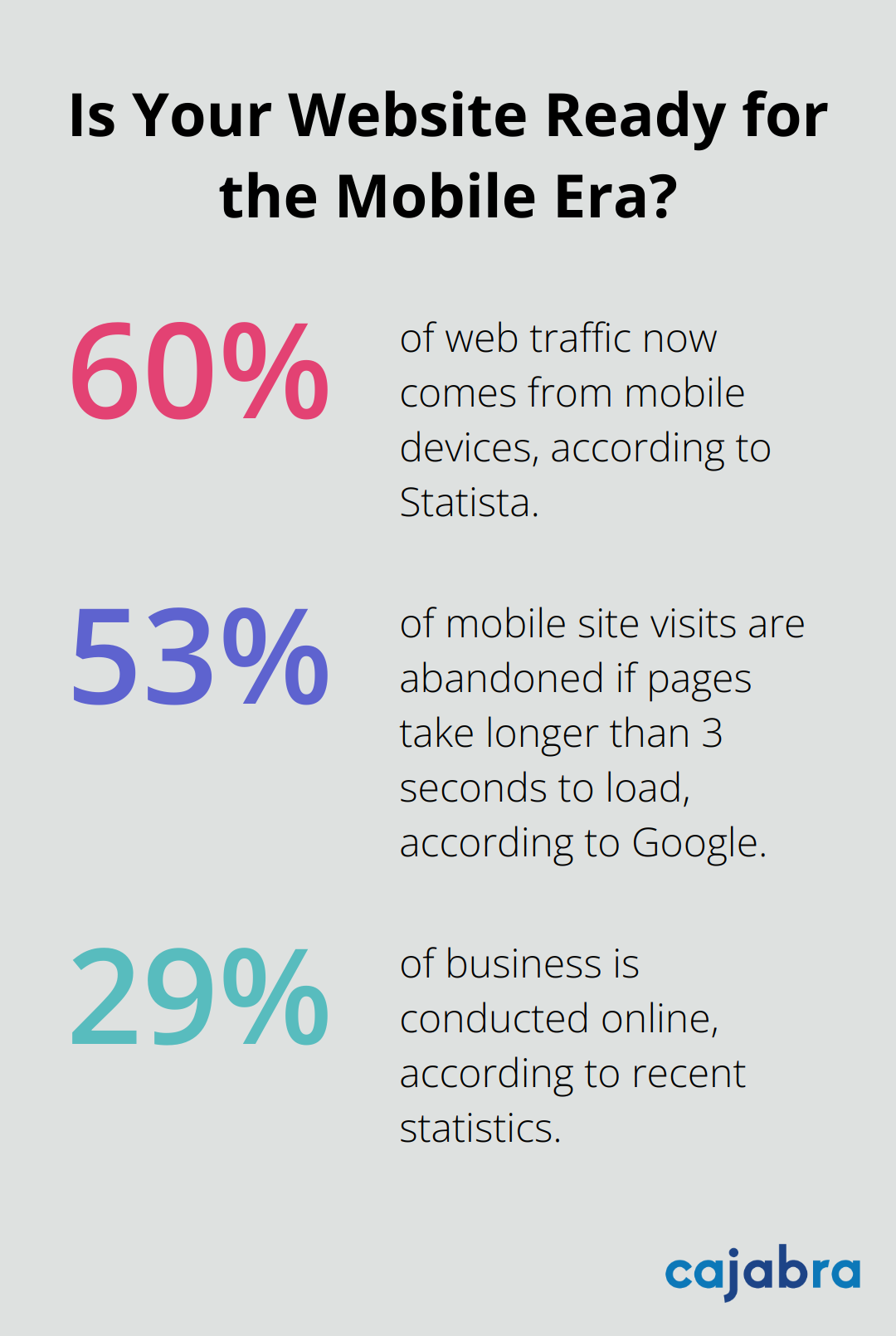
Once you've identified your target keywords, strategically incorporate them into your website's content, meta descriptions, and page titles. However, avoid keyword stuffing – search engines penalize this practice. Instead, focus on creating natural, informative content that addresses your clients' needs.
Adopt a Mobile-First Mindset
Over 60% of web traffic now comes from mobile devices, according to Statista. Your accounting website must be mobile-responsive. This means your site automatically adjusts its layout and functionality to provide an optimal viewing experience across all devices (from smartphones to desktop computers).
Google's mobile-first indexing policy means that the mobile version of your website is now the primary version considered for ranking. Ensure your mobile site loads quickly, has easy-to-tap buttons, and presents information in a clear, concise manner.
Prioritize Speed
Page load speed is essential for both user experience and search engine rankings. According to Google, 53% of mobile site visits are abandoned if pages take longer than 3 seconds to load. To improve your site's speed:
- Optimize image sizes without sacrificing quality
- Minimize HTTP requests by combining files where possible
- Leverage browser caching to store static files
- Use a content delivery network (CDN) to serve files from servers closest to the user's location
Tools like Google's PageSpeed Insights can help you identify specific areas for improvement on your site.
Create Content That Converts
High-quality, relevant content is the cornerstone of both SEO and user engagement. Create in-depth articles, blog posts, and resources that address your clients' most pressing financial questions and concerns. For instance, a comprehensive guide on "Tax Deductions for Small Business Owners" can attract potential clients while showcasing your expertise.
Update your content regularly to stay relevant and signal to search engines that your site is active. Consider creating a content calendar to ensure consistent publishing of fresh, valuable information.
Dominate Local Search
For most accounting firms, local clients are the lifeblood of the business. Optimize your website for local search by:
- Claiming and optimizing your Google Business Profile
- Ensuring your NAP (Name, Address, Phone number) is consistent across all online directories
- Encouraging satisfied clients to leave reviews on Google and other platforms
- Creating location-specific pages if you serve multiple areas
According to recent statistics, 29% of business is conducted online. A strong local SEO strategy ensures your firm appears when potential clients in your area are searching for accounting services.
These strategies will help your accounting firm's website rank higher in search results and provide a superior experience for potential clients. The next chapter will explore how to convert these website visitors into actual clients for your accounting practice.
How to Turn Website Visitors into Paying Clients
Capture Leads with Strategic Forms
We implement strategically placed lead capture forms throughout your website. Research shows that eliminating just one field can increase conversions by a whopping 50%. We keep your forms short, asking only for essential information like name, email, and specific accounting needs.
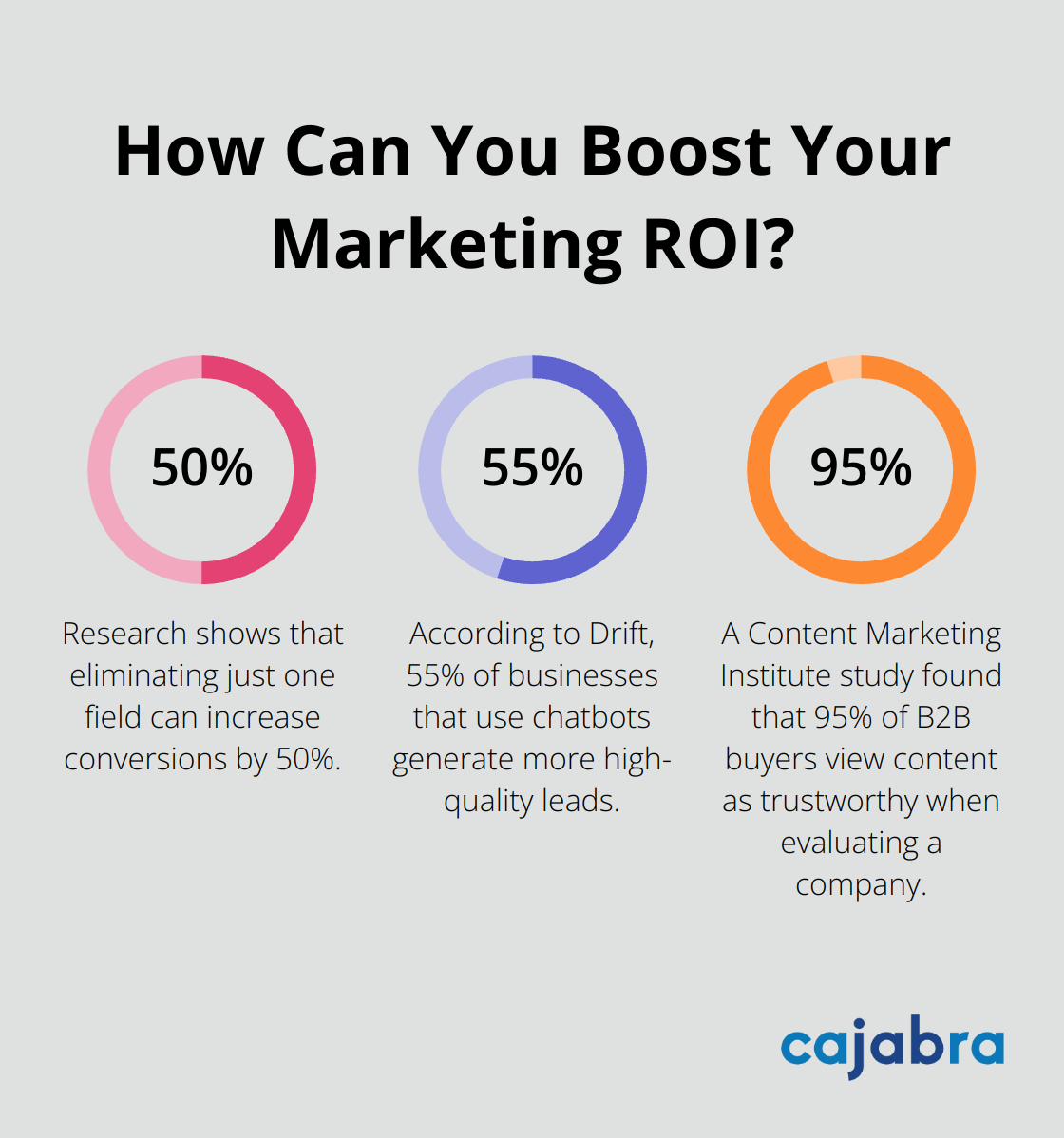
We place these forms at key points in the user journey. For example, after a visitor reads a detailed blog post about tax planning, we offer a free consultation form to capitalize on their interest. HubSpot reports that personalized calls-to-action convert 202% better than generic ones, so we tailor your form's language to the specific content the user has engaged with.
Provide Instant Support with AI-Powered Chatbots
We implement an AI-powered chatbot to provide instant support to website visitors. According to Drift, 55% of businesses that use chatbots generate more high-quality leads. We program your chatbot to answer common questions about your services, pricing, and availability. This immediate response can make the difference between a potential client reaching out or moving on to a competitor.
We ensure your chatbot can seamlessly transfer complex inquiries to a human team member when necessary. This combination of automation and personal touch creates a responsive, client-focused experience that can significantly boost conversion rates.
Offer Valuable Resources to Build Trust
We create downloadable resources that provide immediate value to potential clients. This could include tax preparation checklists, financial planning guides, or industry-specific accounting tips. A Content Marketing Institute study found that 95% of B2B buyers view content as trustworthy when evaluating a company.
We gate these high-value resources behind a simple email sign-up form. This approach not only provides value to the potential client but also allows you to capture their contact information for future marketing efforts. We follow up with automated email sequences that offer additional insights and gently guide the prospect towards scheduling a consultation.
Optimize Your Website for Conversions
We focus on creating a user-friendly website design that guides visitors towards taking action. This includes clear navigation, prominent calls-to-action (CTAs), and strategically placed contact information. We use contrasting colors for CTAs to make them stand out and employ persuasive copy that emphasizes the benefits of your services.
We also implement A/B testing to continuously improve your website's conversion rate. This involves creating two versions of a webpage (with slight variations) and analyzing which one performs better in terms of conversions. Over time, this data-driven approach leads to significant improvements in your website's ability to turn visitors into clients.
Leverage Social Proof
We showcase client testimonials, case studies, and industry awards prominently on your website. This social proof builds trust and credibility with potential clients. We include specific results and metrics in these testimonials (e.g., "Helped us save $50,000 in taxes last year") to make them more impactful.
Final Thoughts
A well-designed website serves as a powerful tool for accounting firms in the digital age. Professional design, user-friendly navigation, and strategic content showcase expertise and build trust with potential clients. Effective accounting website design combines these elements with search engine optimization and user experience enhancements to attract and convert visitors.

We at Cajabra, LLC help accounting firms create websites that drive real business results. Our JAB System™ moves accountants from overlooked to overbooked in 90 days, securing retainer-based clients and maximizing revenue from existing relationships. This system incorporates the strategies discussed in this post, including lead capture forms, AI-powered chatbots, and valuable downloadable resources.
Your website often provides the first impression of your firm to potential clients. Implementing these strategies will create a powerful online presence that sets your accounting firm apart from competitors and consistently attracts high-quality clients. Take action today to transform your website into a client-generating machine.
At Cajabra, LLC, we know how vital it is for financial professionals to stay on top of industry developments.
Accounting news websites are the go-to sources for the latest updates, trends, and regulatory changes in the field.
In this post, we'll guide you through the best online platforms to keep you informed and ahead of the curve in the fast-paced world of accounting.
Where to Find Top-Tier Accounting News
AccountingToday.com: Your Daily Dose of Industry Insights
AccountingToday.com stands out as a premier source for daily updates on accounting trends, technology, and regulatory changes. With over 268,000 Facebook followers, this platform has become a go-to resource for many professionals. The site publishes an average of three posts per day, which keeps you informed about the latest developments in the field.
Journal of Accountancy: AICPA's Authoritative Voice
The Journal of Accountancy, published by the American Institute of CPAs (AICPA), serves over 400,000 members internationally. This resource provides in-depth analysis of complex accounting issues and professional standards. With two posts per week, it offers a steady stream of well-researched content that can directly impact your practice.
CPA Practice Advisor: Technology-Focused Updates
CPA Practice Advisor has covered technology and practice management in accounting since 1991. It publishes two posts per week, making it an excellent resource for information about the latest tools and strategies to enhance your firm's efficiency. Their content often includes practical reviews and comparisons of accounting software and services (which can save you time and money in the long run).
Bloomberg Tax: Comprehensive Tax Intelligence
Bloomberg Tax offers a wealth of information on tax law, international taxation, and financial accounting. Their platform provides daily updates, in-depth analysis, and practical tools that help you navigate complex tax scenarios. Bloomberg's extensive network of experts ensures that the content is both authoritative and actionable (a combination that's hard to find elsewhere).

These four websites form a solid foundation for any financial professional's news diet. Regular engagement with these sources will give you diverse perspectives on industry trends, regulatory updates, and technological advancements. This knowledge will help you make informed decisions and provide top-tier service to your clients.
As we move forward, let's explore some specialized accounting news websites that focus on specific areas of the profession. These niche sources can provide you with targeted information that complements the broader industry news you've just learned about.
Niche Accounting Resources for Specialized Knowledge
International Financial Reporting Standards (IFRS) Updates
IFRS.org provides essential information on global accounting standards. This platform offers timely updates on new standards, interpretations, and amendments. Financial professionals who work with international clients or companies should check this site regularly. IFRS.org presents webcasts, podcasts, and articles that simplify complex standards. Their recent update on IFRS 17 Insurance Contracts included a comprehensive effects analysis (which helps accountants understand the impact on financial statements).
U.S. GAAP and Standard-Setting News
FASB.org is a must-visit site for those working with U.S. Generally Accepted Accounting Principles (GAAP). It presents exposure drafts, final standards, and implementation guidance. FASB's Technical Agenda outlines upcoming changes, allowing accountants to prepare in advance. Their recent Accounting Standards Update on income taxes (ASU 2019-12) simplified accounting for income taxes (affecting many U.S. companies).
Professional Development and Industry Trends
AICPA.org functions as a hub for professional development, ethical standards, and industry trends. It offers numerous resources, including free CPE courses for members. The AICPA's Trends Report provides valuable insights into the accounting profession's demographics and future outlook. Their 2019 report showed a 6% decrease in CPA Exam candidates who passed their 4th section of the exam between 2017 and 2018.
Tax Updates and Regulatory Changes
IRS.gov is an indispensable resource for tax professionals. It provides the latest tax law changes, forms, and publications. The site's "News" section offers timely updates on tax-related issues. During the COVID-19 pandemic, the IRS website became a critical source for information on stimulus payments and tax relief measures. Their "Tax Pros" section offers specialized content for accounting professionals, including e-Services tools and preparer regulations.
Cajabra's Specialized Marketing Resources
While the aforementioned resources focus on accounting standards and regulations, Cajabra, LLC offers specialized marketing resources tailored for accounting firms. Our JAB System™ helps move accountants from overlooked to overbooked in just 90 days by securing retainer-based clients. We provide four eBooks with strategies on AI-powered marketing and automated systems for consistent cash flow. Our Client Optimizer tool captures ideal clients and enhances online reputation.

These specialized resources offer not just news, but also practical tools and in-depth analyses that can directly impact your work and client service. The next section will explore how social media platforms complement these traditional news sources in keeping financial professionals informed and connected.
Leveraging Social Media for Accounting Insights
Social media platforms serve as powerful tools for financial professionals to stay informed and connected. These platforms offer real-time updates, diverse perspectives, and networking opportunities that complement traditional news sources.
LinkedIn: The Professional's Information Hub
LinkedIn stands out as the top platform for accounting professionals. Groups like Accounting & Finance Professionals and Tax Professionals Network provide spaces for discussions and insight sharing. Industry leaders such as Kimberly Ellison-Taylor, former AICPA Chair, post regularly about emerging trends in accounting technology. LinkedIn's algorithm determines what content is prioritized in your feed and the amount of reach your content receives, making it easier to find relevant information without the noise of other social platforms.
Twitter: Real-Time Updates and Expert Opinions
Twitter's fast-paced nature makes it ideal for breaking news and quick insights. Accounts like @AICPA_JofA deliver timely articles from the Journal of Accountancy, while @Bloomberg_Tax provides tax policy updates. Industry thought leaders like Tom Hood (@tomhood) share valuable perspectives on the future of accounting. Hashtags like #TaxTwitter allow professionals to join conversations about current tax issues and find answers to complex questions from peers (often in real-time).
Reddit: Community-Driven Discussions
Reddit's accounting communities offer a unique blend of professional insights and peer support. The r/Accounting subreddit contains industry discussions, career advice, and even humor related to the accounting profession. One of the biggest issues discussed is pay, which hasn't kept up with other fields. Companies often view accounting and finance as cost centers rather than revenue or growth drivers. r/Tax provides a platform for tax professionals to discuss complex cases and share interpretations of new regulations. These communities often feature AMAs (Ask Me Anything) sessions with industry experts, which provide direct access to valuable knowledge.
Facebook: Firm Updates and Industry News
While not traditionally associated with professional content, Facebook hosts pages for many accounting firms and professional bodies. These pages often share industry news, firm updates, and educational content. Following pages like "Accounting Today" or "The CPA Journal" can provide a mix of professional insights and lighter content related to the accounting world.
Instagram: Visual Insights and Firm Culture
Instagram might seem an unlikely platform for accounting professionals, but it offers unique opportunities. Many firms use it to showcase their company culture, share infographics about financial concepts, and connect with younger professionals. Accounts like @thebigfour and @accountingmemes provide a lighter take on the profession, while still offering valuable insights.
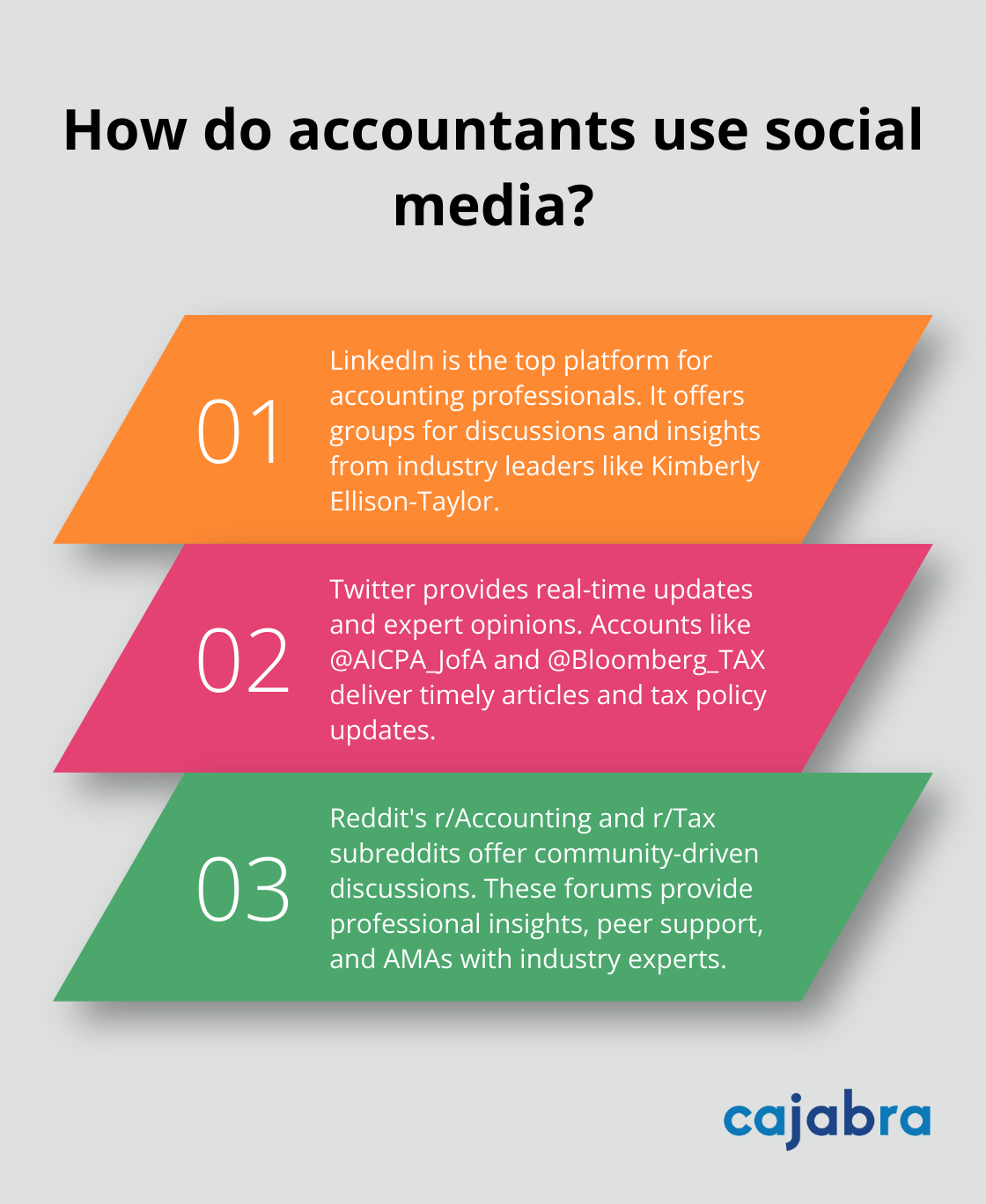
Final Thoughts
Accounting news websites provide essential information for financial professionals to excel in their field. These platforms offer diverse perspectives on industry trends, regulatory updates, and technological advancements. Professionals who engage with multiple news sources position themselves as knowledgeable experts in the eyes of clients and peers.
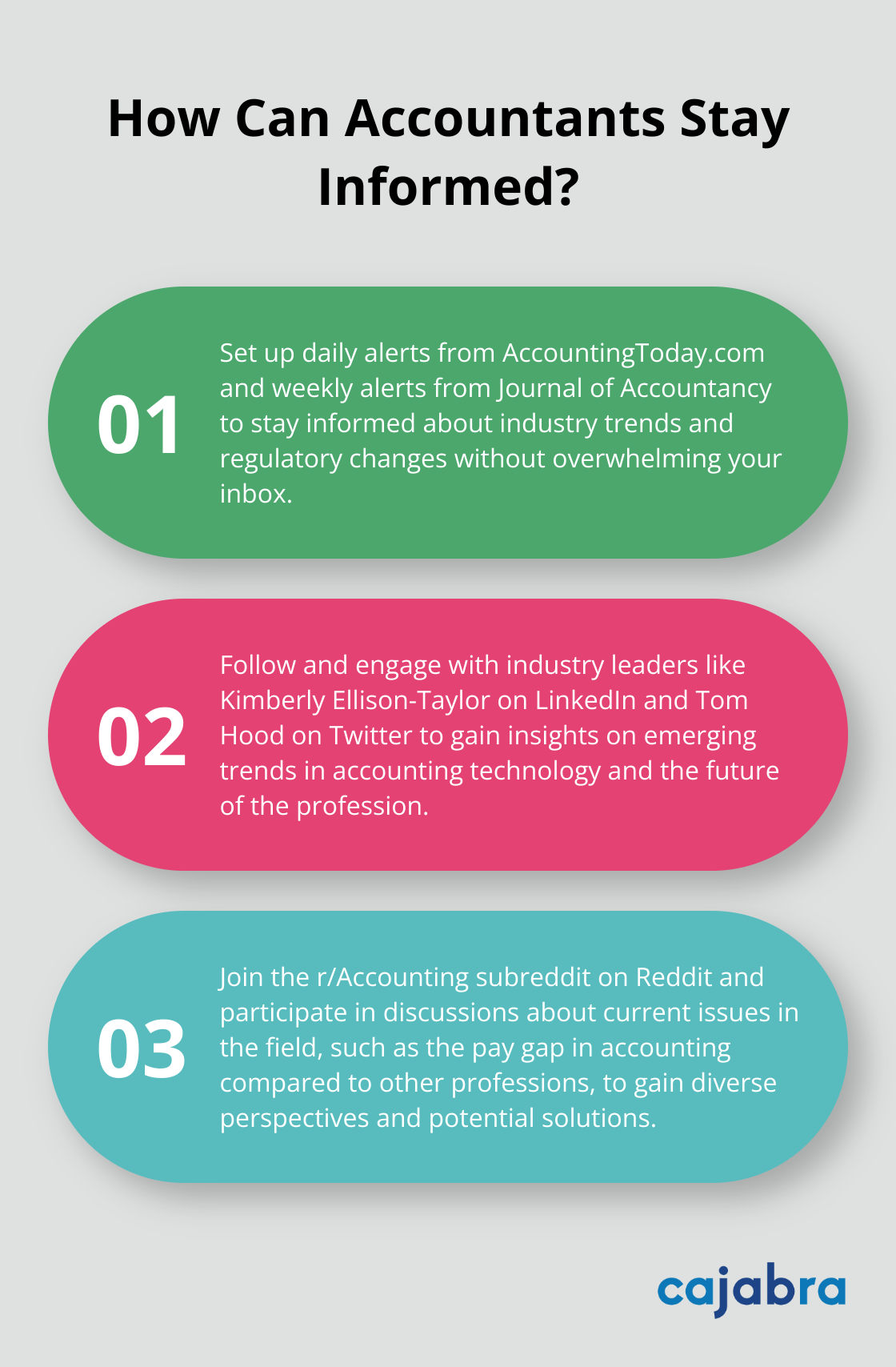
The accounting landscape evolves rapidly, and those who stay informed thrive. Professionals should explore the mentioned accounting news websites and select reliable sources that meet their specific needs. This approach allows accountants to anticipate changes, adapt to new requirements, and identify growth opportunities.
While staying updated on industry news matters, growing your accounting practice is equally important. Cajabra's specialized marketing services can help accountants secure retainer-based clients and boost their practice (our JAB System™ aims to transform practices in just 90 days). We handle marketing aspects, allowing you to focus on serving clients and applying your expertise.
At Cajabra, LLC, we know that a strong content messaging strategy is the backbone of effective brand communication. Your brand values are more than just words on a page; they're the essence of your company's identity.
In this post, we'll explore how aligning your content with your core values can transform your marketing efforts and build lasting connections with your audience. We'll provide practical strategies to help you create messaging that resonates with your customers and reflects what your brand truly stands for.
Why Brand Values Matter in Marketing
The Foundation of Brand Identity
Brand values form the core of a company's identity and guide its actions. These principles shape how a business operates and communicates with its audience. Companies that clearly define and live by their values create a strong foundation for all marketing efforts.
The Power of Value-Driven Marketing
Value-driven marketing creates a powerful connection with consumers. A 2023 Edelman study revealed that 64% of consumers make purchasing decisions based on a brand's stance on societal issues. This statistic highlights the importance of authentic value communication in content.
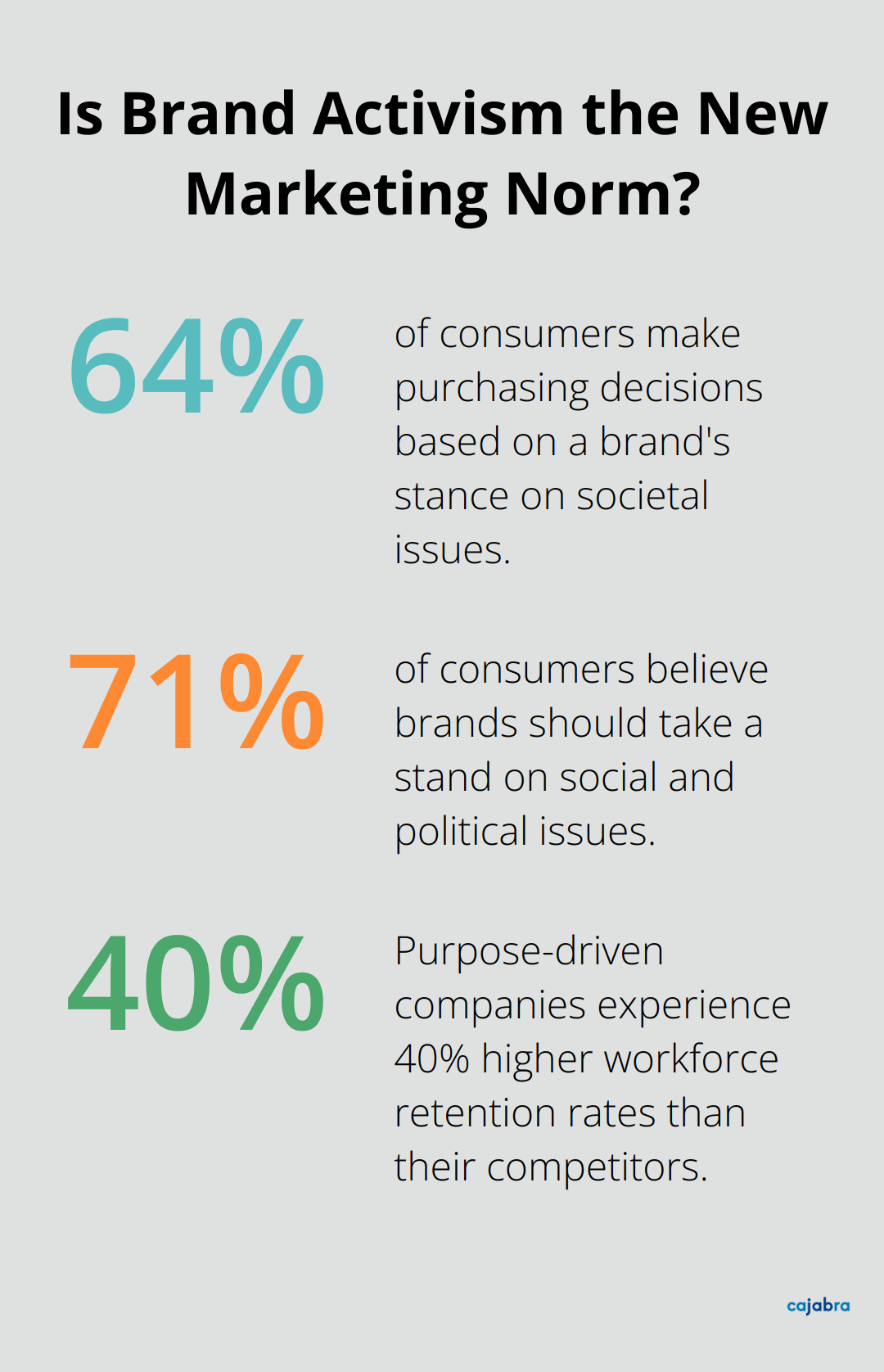
Patagonia exemplifies this approach. Their commitment to environmental sustainability permeates their business model and messaging. This alignment has cultivated a loyal customer base, resulting in impressive growth (30% year-over-year in 2021, as reported by Forbes).
Shaping Consumer Perception
Brand values act as a lens through which consumers view a company. A 2022 Sprout Social survey found that 71% of consumers believe brands should take a stand on social and political issues. This doesn't necessitate commenting on every topic, but it underscores the importance of clear communication on issues that align with brand values.
Ben & Jerry's demonstrates this principle effectively. Their vocal support for social justice issues has become an integral part of their brand identity. While this approach may not appeal to everyone, it has strengthened their connection with their target audience and set them apart in a competitive market.
Impact on Customer Loyalty
Value-aligned messaging doesn't just attract customers-it fosters long-term loyalty. A 2022 Deloitte report found that purpose-driven companies experience 40% higher workforce retention rates than their competitors. This principle extends to customer retention as well.
When customers feel a brand's values align with their own, they often become loyal advocates. This loyalty translates into tangible benefits: a Bain & Company study showed that a mere 5% increase in customer retention rates can boost profits by 25% to 95%.
The Role of Consistent Communication
Consistent communication of values through content invites customers to join a community that shares their beliefs and aspirations. This emotional connection transforms one-time buyers into lifelong customers and brand ambassadors.
As we move forward, we'll explore practical strategies for aligning your content with your brand values, ensuring that every piece of communication reinforces your company's core principles and resonates with your target audience.
How to Align Your Content with Brand Values
Conduct a Brand Value Audit
Start with a thorough examination of your current brand values. Are they still relevant? Do they resonate with your target audience? A 2018 Accenture study found that consumers support companies whose brand purpose aligns with their beliefs, and one in five will walk away forever from brands that don't. This highlights the importance of up-to-date, meaningful brand values.
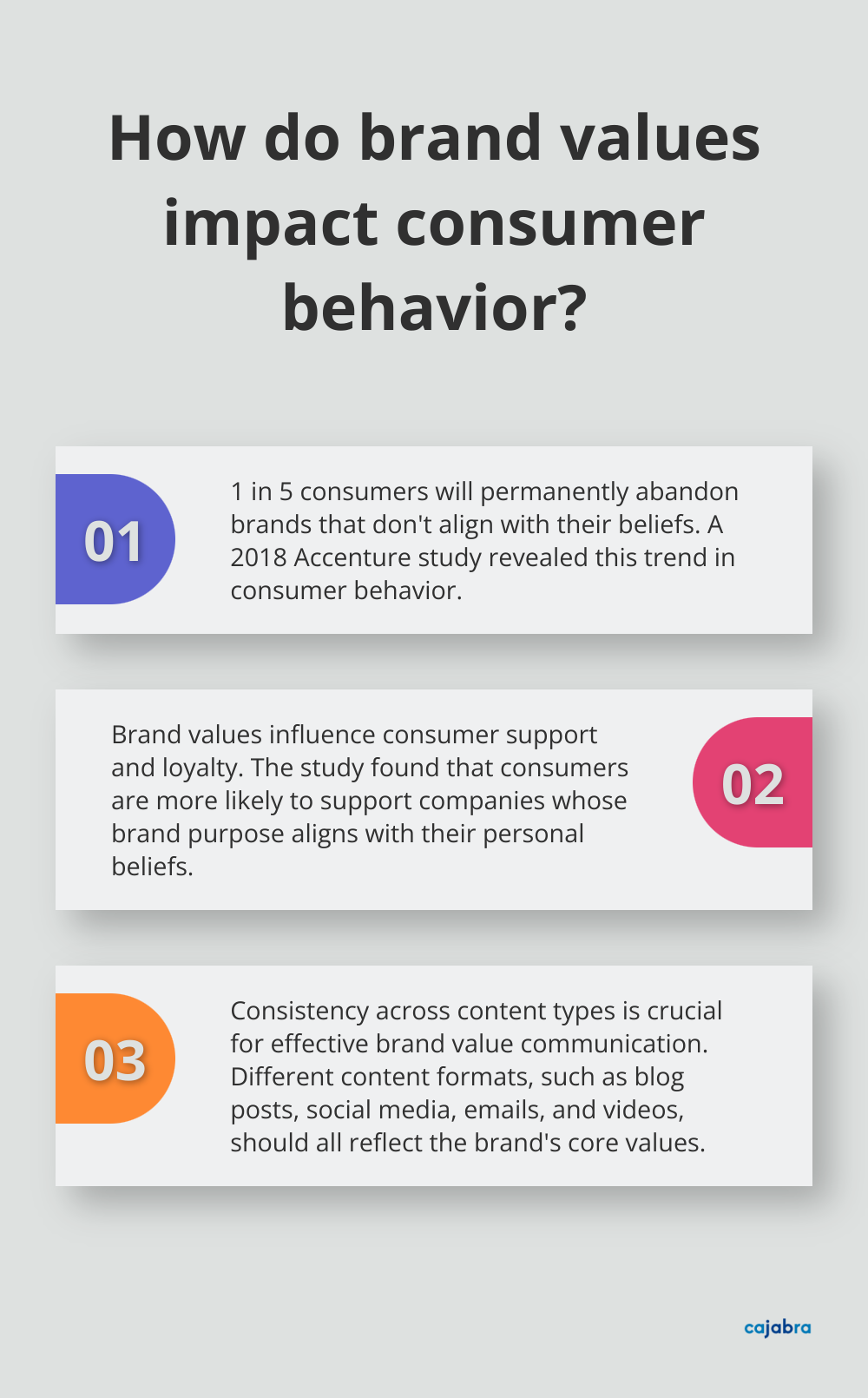
To conduct an effective audit, survey your employees and customers. Ask what values they associate with your brand. Compare these responses to your stated values. If there's a disconnect, it's time to reassess and potentially update your brand values.
Create a Comprehensive Brand Voice Guide
After you've solidified your brand values, develop a brand voice guide. This document should outline how your values translate into tone, language, and messaging across all platforms.
Include specific examples of do's and don'ts. For instance, if one of your values is innovation, your guide might encourage the use of forward-thinking language and discourage outdated industry jargon.
HubSpot's brand pillars serve as an excellent example. They help define a brand's purpose, values, and identity for continued growth.
Develop a Value-Driven Content Strategy
Your content strategy should directly reflect your brand values. If sustainability is a core value, ensure a significant portion of your content addresses environmental issues or showcases your sustainable practices.
Patagonia excels at this. Their Worn Wear program, which encourages repairing and recycling clothing, features prominently in their content strategy. This aligns perfectly with their value of environmental responsibility.
When you plan content, ask yourself: "How does this piece reflect our brand values?" If you can't answer this question, reconsider the content.
Incorporate Values Across All Content Types
Different content types offer unique opportunities to showcase your brand values:
-
Blog posts: Use these for in-depth explorations of topics related to your values. For example, if transparency is a key value, consider a series detailing your supply chain or pricing structure.
-
Social media: Use platforms like Instagram or Twitter for quick, impactful statements about your values. Ben & Jerry's does this effectively, using their social channels to advocate for social justice causes.
-
Email campaigns: Personalize your emails to reflect how your values align with your customers' interests.
-
Video content: Use this powerful medium to show your values in action. Dove's Real Beauty campaign is a prime example, using video to challenge beauty standards and promote self-esteem.
Consistency is key. Your brand values should be evident whether someone reads a blog post, scrolls through your Instagram, or opens your newsletter.
The implementation of these strategies will create a cohesive brand message that resonates with your audience and sets you apart in the marketplace. Now, let's explore how to measure the impact of your value-aligned content in the next section.
Measuring Value-Aligned Content Success
Key Performance Indicators for Value-Aligned Messaging
To evaluate the effectiveness of your value-aligned content, focus on these key performance indicators (KPIs):
-
Engagement Rates: Monitor likes, shares, comments, and time spent on content. Higher engagement often indicates that your values resonate with your audience.
-
Conversion Rates: Track how often your value-aligned content leads to desired actions (e.g., newsletter sign-ups or product purchases).
-
Brand Sentiment: Use social listening tools to analyze how people talk about your brand online. Positive sentiment can indicate successful value communication.
-
Customer Loyalty Metrics: Measure repeat purchase rates and customer lifetime value. Customers who align with your values are more likely to stay loyal.
-
Employee Satisfaction: Don't overlook internal metrics. Employees who understand and believe in your brand values tend to be more engaged and productive.
Tools and Techniques for Tracking Content Performance
To effectively measure these KPIs, leverage these tools:
-
Google Analytics: This free tool provides in-depth website traffic analysis, including engagement metrics and conversion tracking.
-
Social Media Analytics: Platforms like Sprout Social or Hootsuite offer comprehensive social media performance tracking.
-
Sentiment Analysis Tools: Brandwatch or Mention can help you gauge public perception of your brand.
-
Customer Relationship Management (CRM) Systems: Tools like Salesforce or HubSpot can track customer interactions and loyalty over time.
-
Employee Feedback Platforms: Use tools like Culture Amp or 15Five to measure how well your team aligns with and embodies your brand values.
Case Studies of Successful Value-Aligned Content Campaigns
Let's examine some brands that have successfully aligned their content with their values and reaped the benefits:
Patagonia's "Don't Buy This Jacket" Campaign: This counterintuitive campaign told customers not to buy their jacket. The message was intended to encourage people to consider the environmental impact of their purchases. It aligned perfectly with Patagonia's sustainability values.
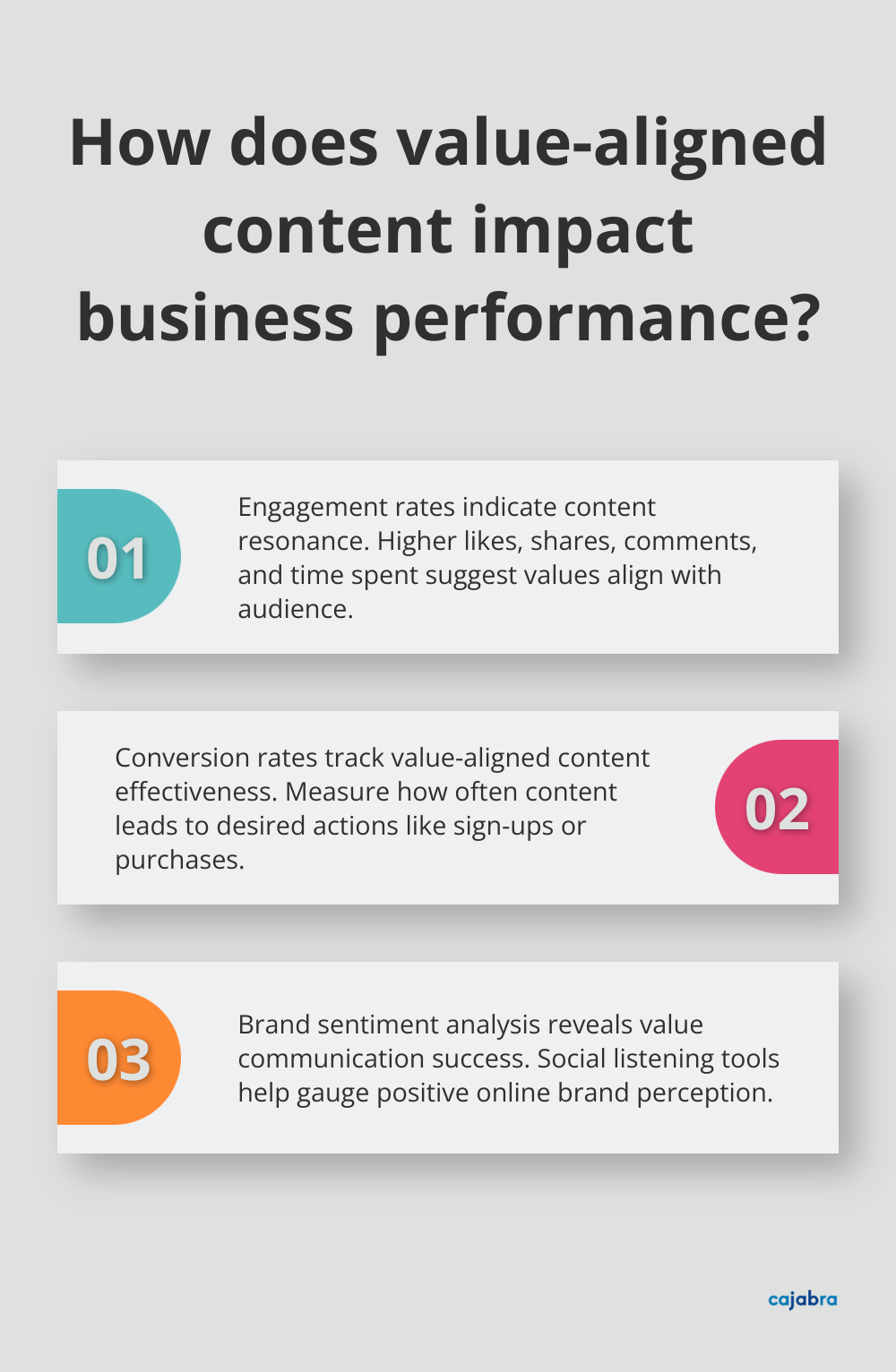
Dove's Real Beauty Campaign: This campaign challenged beauty standards and promoted self-esteem. Dove saw a significant increase in engagement rates on social media and an increase in sales within the first year of the campaign.
REI's #OptOutside Initiative: REI decided to close its stores on Black Friday and encourage people to spend time outdoors instead. They saw a substantial increase in social media engagement and an uptick in membership applications.
These examples show that when brands truly commit to their values and reflect them in their content, the results can transform their business. In the accounting industry, firms that align their content with values like transparency, expertise, and client-centricity (core principles of Cajabra's JAB System™) have seen significant increases in engagement and client acquisition.
Ongoing Measurement and Adjustment
Measuring the impact of value-aligned content requires an ongoing process. Try to review your metrics regularly and adjust your strategy as needed. This approach will not only improve your marketing performance but also strengthen your overall brand identity.
Final Thoughts
A strong content messaging strategy aligned with brand values sets companies apart in today's competitive landscape. This approach fosters deep connections with audiences and builds trust through authentic communication. Companies that clearly express their values and support them with action will thrive as consumers become more selective about the brands they support.
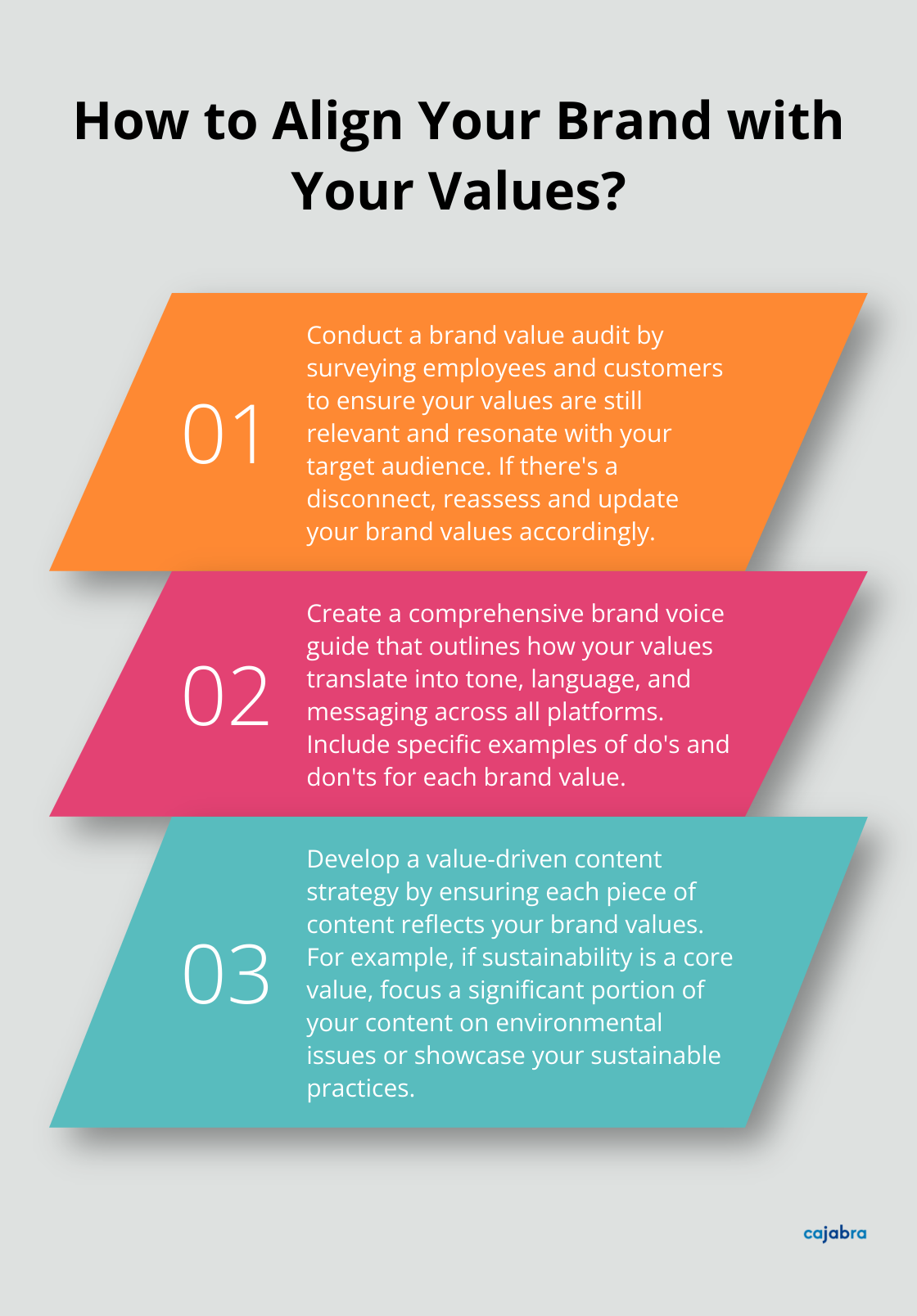
We expect more brands to take stands on social and environmental issues, using their platforms to drive positive change. This trend will strengthen market positions while contributing to broader societal goals. A robust strategy rooted in brand values creates a meaningful dialogue with audiences, transcending mere marketing efforts.
At Cajabra, we understand the power of value-aligned messaging in the accounting industry. Our JAB System™ helps accounting firms develop strong brand identities and create content that resonates with ideal clients. This approach can transform firms from overlooked to overbooked, attracting clients who appreciate what they stand for.
Mobile messaging has become a powerhouse in customer engagement. At Cajabra, LLC, we've seen firsthand how this direct, personal approach can transform businesses.
A well-crafted mobile messaging strategy is key to reaching customers on their most-used devices. In this post, we'll explore effective tactics and overcome common challenges to help you connect with your audience on the go.
Why Mobile Messaging Matters
The Power of Instant Communication
Mobile messaging has revolutionized customer engagement. Recent data shows that text messages can yield an average open rate of up to 95%. This high engagement rate makes mobile messaging an indispensable tool for businesses across all sectors.
The Mobile-First Revolution
The shift towards mobile-first communication is undeniable. By the end of 2023, almost 70 percent of the world's population were smartphone users. This trend has transformed how businesses approach customer engagement, placing mobile messaging at the forefront of marketing strategies.
Real-Time Interaction, Lasting Results
Mobile messaging enables immediate interaction with customers, creating opportunities for instant engagement. This immediacy proves particularly effective for time-sensitive offers or urgent communications. SMS open and response rates can reach as high as 98% and 45%, respectively, compared to email's 20% open rate and 6% response rate (Gartner).
Personalization at Scale
One of the most significant advantages of mobile messaging is its ability to deliver personalized content to a large audience. Businesses can tailor messages to individual preferences, behaviors, and purchase history by leveraging customer data. This level of personalization significantly boosts engagement and conversion rates. In fact, 80% of consumers are more likely to make a purchase when brands offer personalized experiences (Epsilon).
Transforming Customer Relationships
Mobile messaging has the power to transform customer relationships across various industries. For example, accounting firms can strengthen their position as trusted advisors by delivering targeted, relevant content directly to clients' mobile devices. This approach can drive more retainer-based business and foster long-term client loyalty.
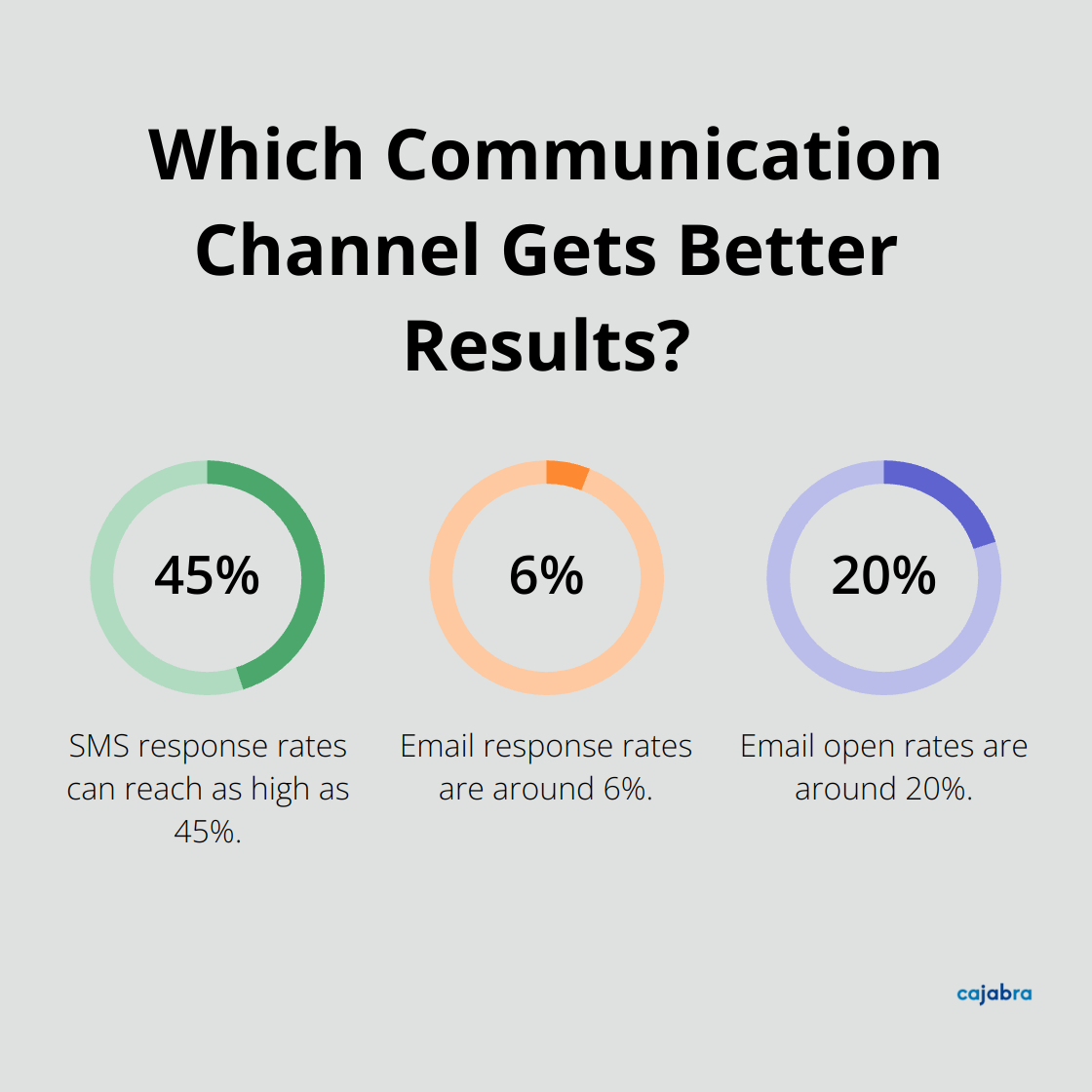
As we move forward, let's explore the effective strategies that can maximize the impact of your mobile messaging campaigns and help you connect with your audience on a deeper level.
How to Craft Effective Mobile Messages
Mobile messaging is a powerful tool, but its effectiveness depends on how well you craft your messages. Let's explore the strategies that can maximize the impact of your mobile messaging campaigns.
Keep It Short and Sweet
The key to successful mobile messaging is brevity. The ideal length for an SMS message ranges between 60 to 160 characters. This constraint forces you to focus on your core message, eliminate fluff, and get straight to the point. For example, instead of a lengthy explanation about a new service, try: "New tax planning service available. Book your consultation today!"
Perfect Your Timing
Timing plays a critical role in mobile messaging. The best times for businesses to send marketing text messages are generally between 9 AM and 12 PM, and then again from 5 PM to 9 PM on weekdays. However, these times can vary depending on your specific audience. Test different send times and analyze open rates to find what works best for your clients.
Personalize for Impact
Personalization significantly boosts engagement. Use customer data to tailor your messages. For accounting firms, this could mean sending tax deadline reminders based on a client's business structure or offering personalized financial advice based on their previous interactions.
Leverage Multimedia
While text-only messages can be effective, incorporating multimedia can boost engagement. MMS messages have a slightly higher average revenue per recipient compared to SMS, although the rates for SMS and MMS are almost identical. Accounting firms could send infographics summarizing tax changes or short video explanations of complex financial concepts.
Optimize for Action
Every message should have a clear call-to-action (CTA). Whether it's "Book Now," "Learn More," or "Claim Your Offer," your CTA should be concise and compelling. Try to create a sense of urgency (e.g., "Limited spots available" or "Offer ends tonight") to encourage immediate action.
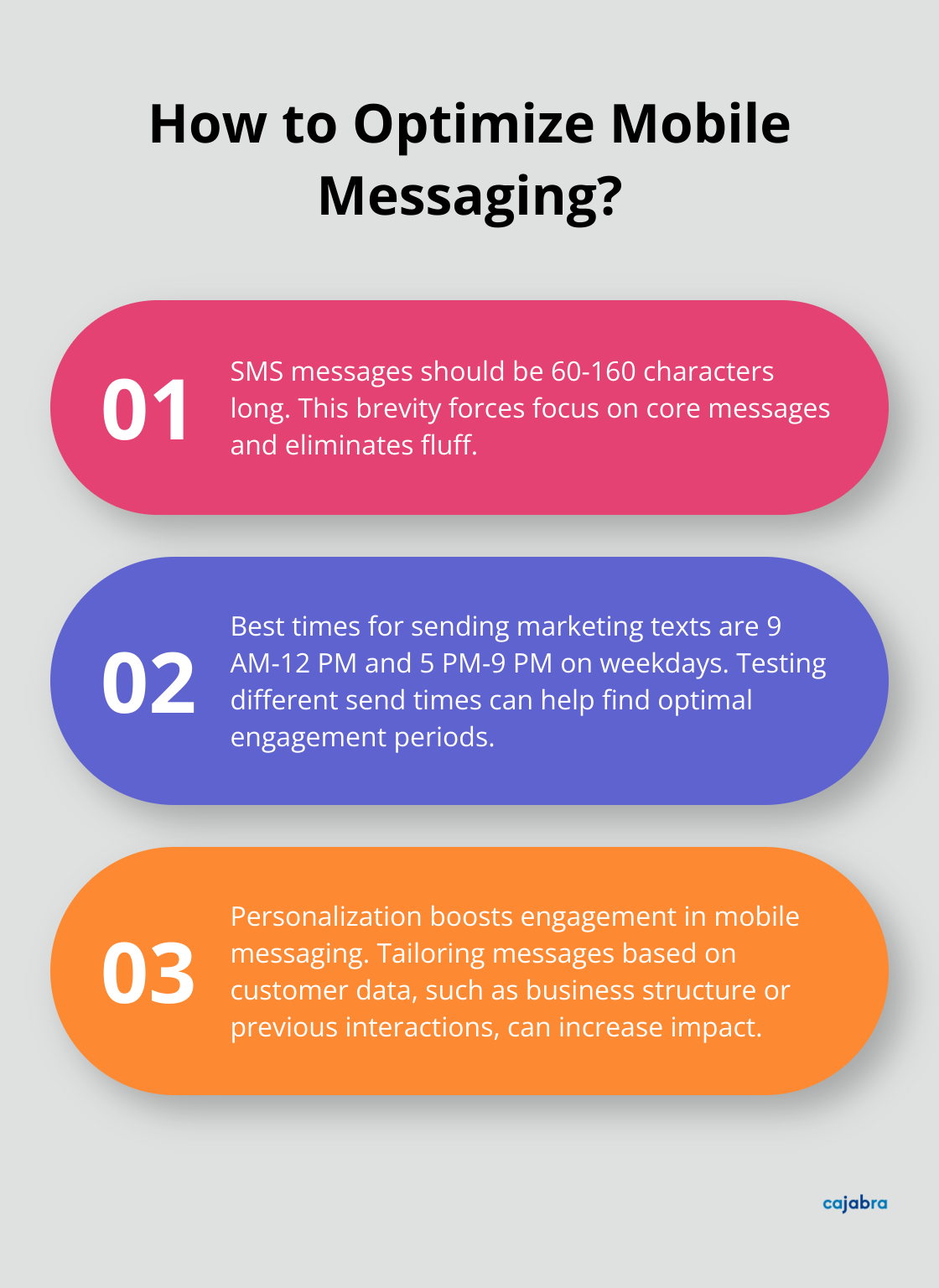
The art of crafting effective mobile messages lies in balancing brevity, timing, personalization, and compelling content. As we move forward, let's explore how to overcome common challenges in mobile messaging to ensure your campaigns reach their full potential.
Navigating Mobile Messaging Hurdles
Protect Privacy While Personalizing
Respecting customer privacy stands as a top priority in mobile messaging. You must obtain explicit consent before sending any messages. SMS is proving critical for keeping brands top of mind, with 56 percent of survey respondents being reminded about a brand they'd forgotten due to a text message. Implement a clear opt-in process and provide easy opt-out options in every message. This approach not only complies with regulations (like GDPR and CCPA) but also builds trust with your audience.
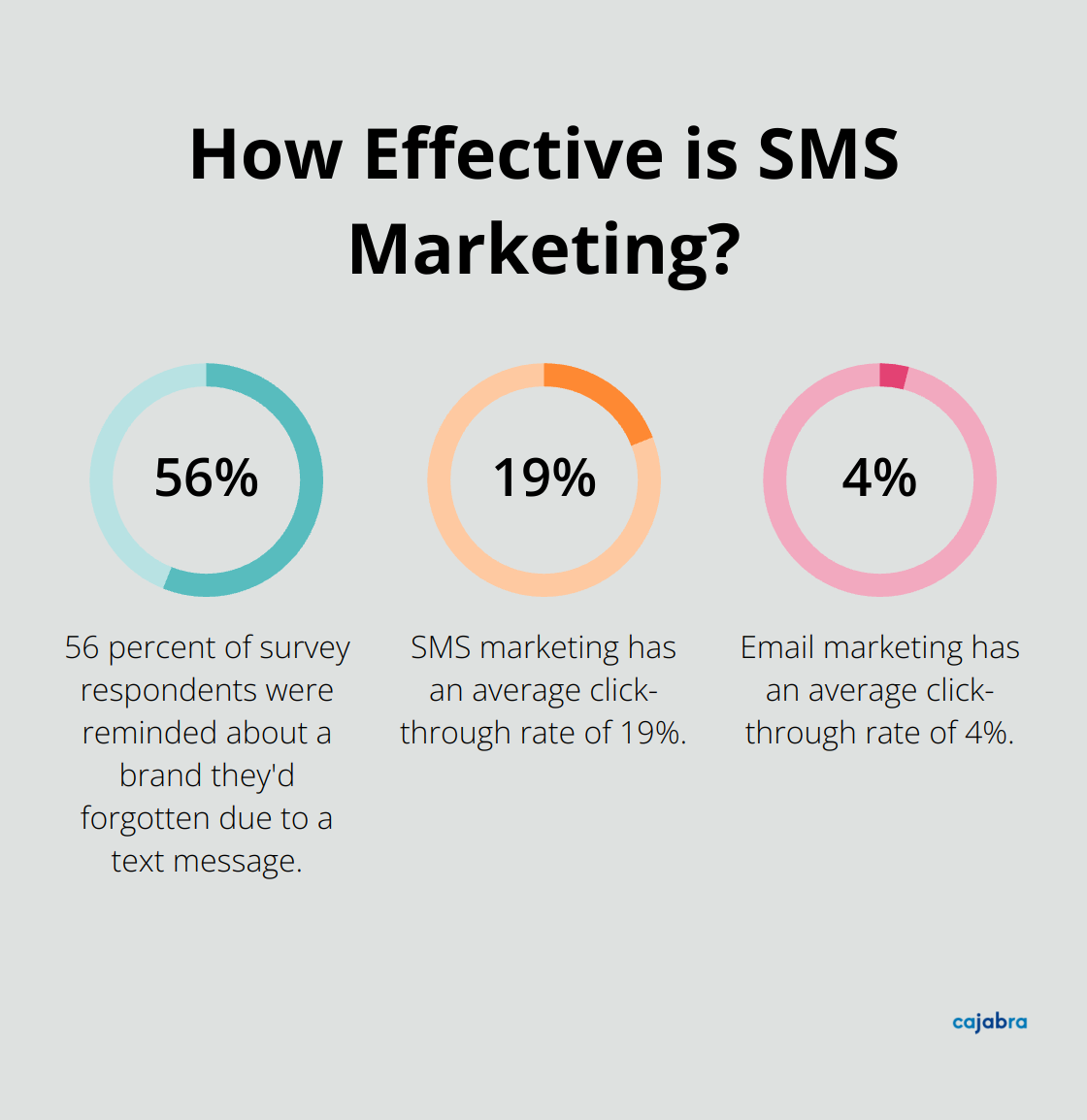
To personalize messages without breaching privacy, use data that customers have willingly shared. For example, you could send tax deadline reminders based on the type of business a client runs, without mentioning sensitive financial details.
Avoid the Spam Trap
Managing message volume prevents your communications from being perceived as spam. A study found that 62% of consumers would unsubscribe if they received too many messages. Try to prioritize quality over quantity. For accounting firms, this might mean sending monthly tax tips rather than weekly updates.
To further avoid the spam label, vary your message content. Mix informational messages with promotional ones. For instance, alternate between sharing tax-saving strategies and promoting your services. This approach provides value to clients while keeping them engaged with your brand.
Ensure Cross-Device Compatibility
With the variety of mobile devices in use, your messages must display correctly across all platforms. Keep your messages simple and avoid complex formatting. If you include links, use a URL shortener to ensure they're easily clickable on any device. For multimedia messages, compress images and videos to ensure quick loading times across different network speeds.
Measure Success Accurately
Analyzing the effectiveness of your mobile messaging campaigns improves your strategy over time. Key metrics to track include open rates, click-through rates, and conversion rates. SMS marketing has an average click-through rate of 19%, significantly higher than email marketing's 4%.
Use A/B testing to refine your messaging strategy. Test different elements like message length, tone, and call-to-action phrases. For accounting firms, you might compare the effectiveness of messages focusing on tax savings versus those highlighting financial planning services.
Final Thoughts
Mobile messaging has revolutionized customer engagement with its unparalleled open rates and personalization capabilities. A well-crafted mobile messaging strategy can significantly boost customer engagement, drive conversions, and foster long-term loyalty. The future of mobile communication will likely see increased integration of AI and machine learning to further personalize messages and predict customer behavior.
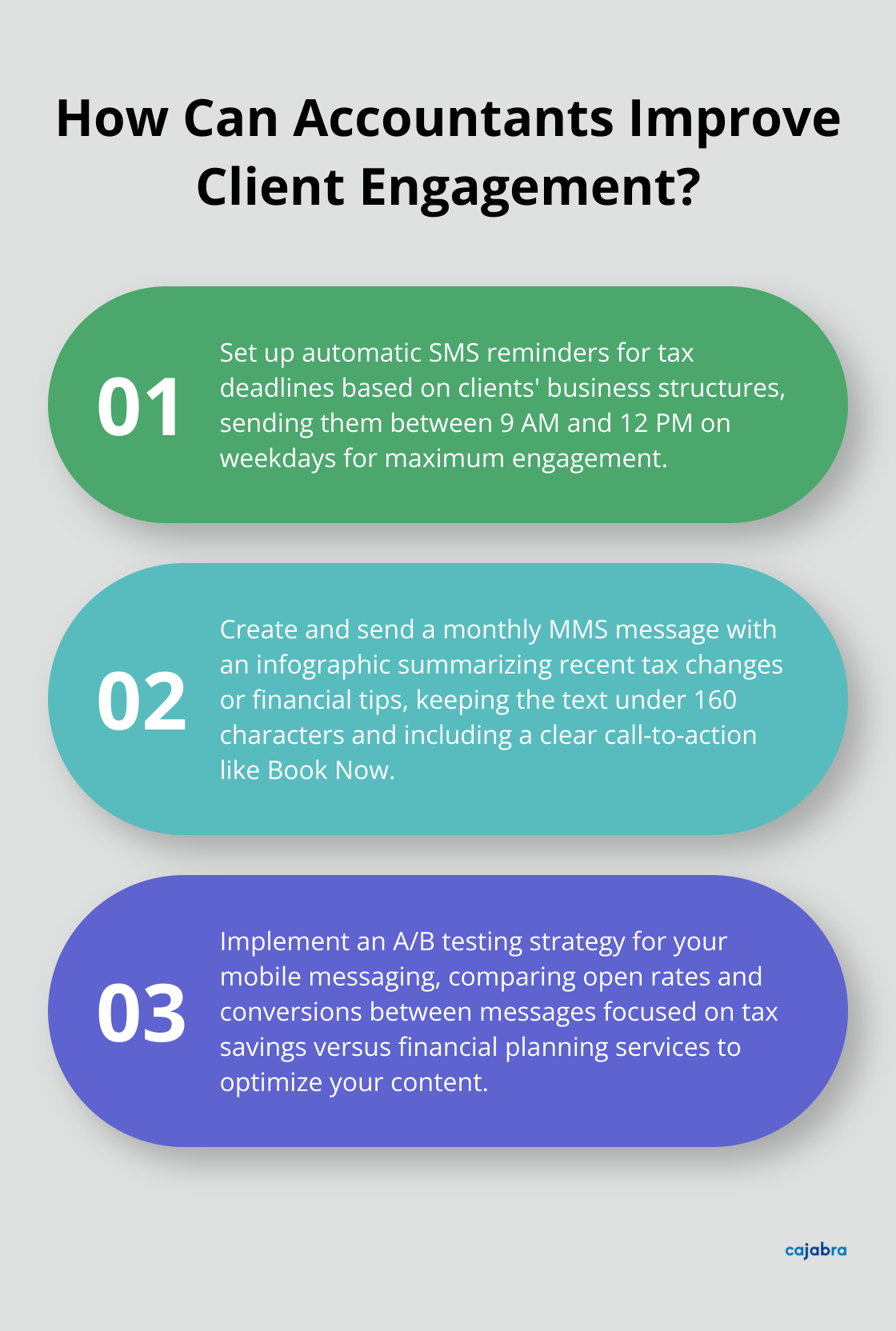
As customer preferences shift towards more immediate, personalized communication, businesses must adapt their strategies accordingly. This means embracing mobile messaging and continuously refining approaches based on data-driven insights and emerging trends. At Cajabra, we understand the power of effective mobile messaging strategies, especially for accounting firms looking to stand out in a competitive market.
Our specialized marketing services help accountants leverage these powerful communication tools. We implement our JAB System™ and utilize our suite of marketing solutions to assist accounting firms in harnessing the full potential of mobile messaging (to secure retainer-based clients and position themselves as industry leaders). Businesses that master the art of mobile messaging will have a significant advantage in today's mobile-first world.
At Cajabra, LLC, we know that a strong product messaging strategy can make or break your marketing efforts.
It's the key to connecting with your audience, highlighting your unique value, and driving sales. In this post, we'll guide you through the process of creating a powerful product messaging strategy that resonates with your target market.
Get ready to transform how you communicate your product's value to potential customers.
Who Is Your Target Audience?
Conduct In-Depth Market Research
To create a powerful product messaging strategy, you must first understand your target audience. Start with comprehensive market research. This involves more than just reading industry reports. Engage directly with potential customers through surveys, interviews, and focus groups. This approach yields real, actionable data. For example, a recent study revealed that 78% of consumers will do business with a company again after a mistake if the company's customer service is excellent.
Create Detailed Buyer Personas
After gathering research, develop buyer personas. These are not mere demographic profiles; they represent detailed portraits of your ideal customers. Include their goals, challenges, and decision-making processes. In the accounting sector, for instance, many target customers are small business owners (aged 35-50) who prioritize time-saving solutions and personalized financial advice.
Identify Pain Points and Needs
Effective product messaging addresses specific customer pain points. Analyze your research to pinpoint these issues. In the accounting field, a major pain point is the absence of proactive financial planning from accountants. This insight allows for tailored messaging that highlights how accounting firms can provide forward-thinking financial advice.
Segment Your Audience
Not all customers are the same. Segment your audience based on shared characteristics (e.g., industry, company size, or specific needs). This segmentation allows for more targeted and relevant messaging. For example, a mid-sized manufacturing company will have different accounting needs than a small retail business.
Monitor Audience Trends
Customer needs and market conditions evolve. Regularly update your audience understanding to keep your messaging relevant and impactful. Set up systems to track industry trends, customer feedback, and market shifts. This ongoing process ensures your product messaging remains aligned with your audience's current needs and preferences.
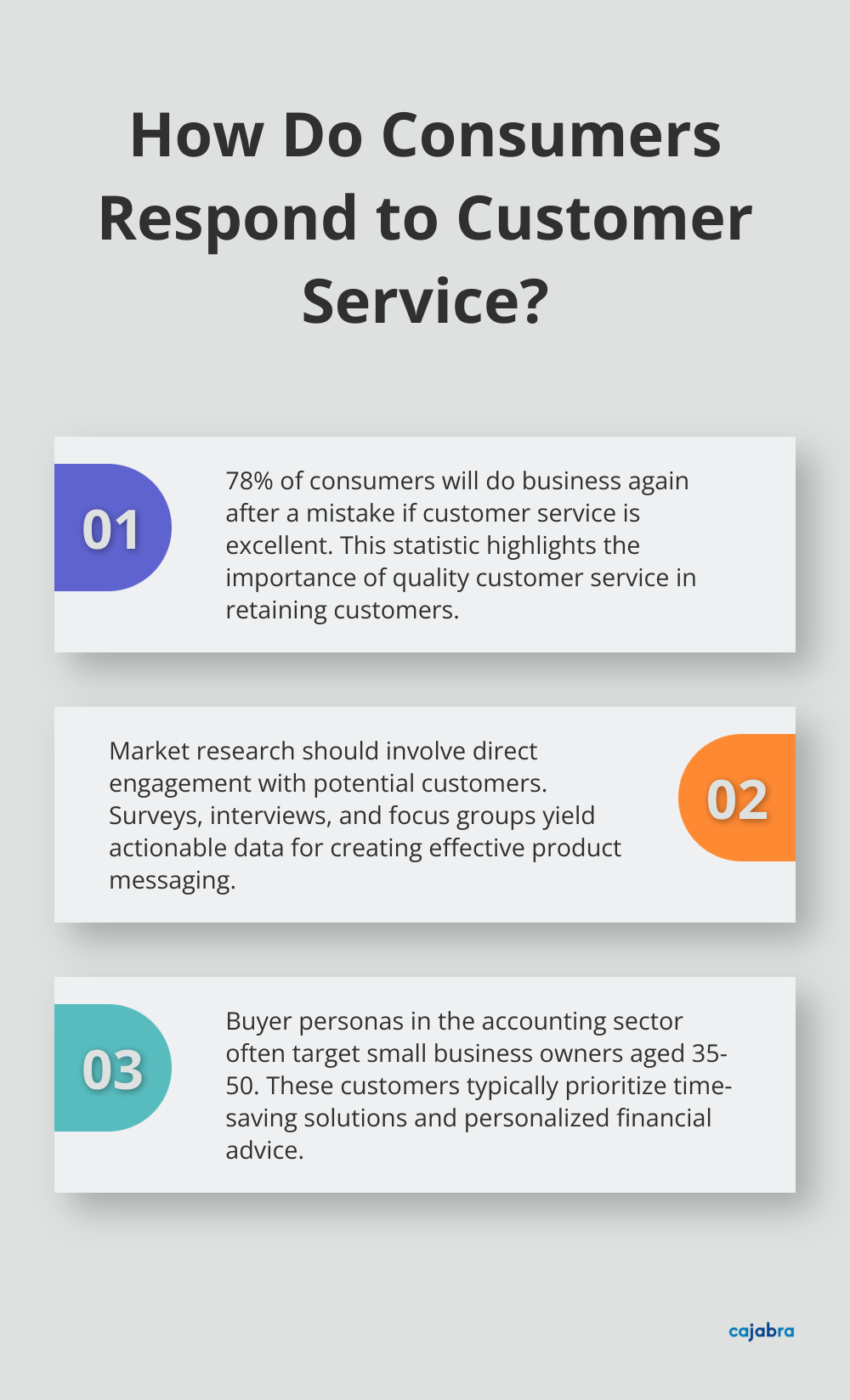
As you develop a deep understanding of your target audience, you'll be well-positioned to craft a core message that resonates powerfully with potential customers. Let's explore how to define your unique value proposition and develop a compelling brand story in the next section.
How to Craft a Compelling Core Message
Define Your Unique Value Proposition
Your unique value proposition (UVP) forms the foundation of your core message. It distinguishes you from competitors and explains the benefits of your product, how it solves customers' problems, and why it is different from others. Analyze your product's strengths and how they address your audience's pain points to define your UVP.
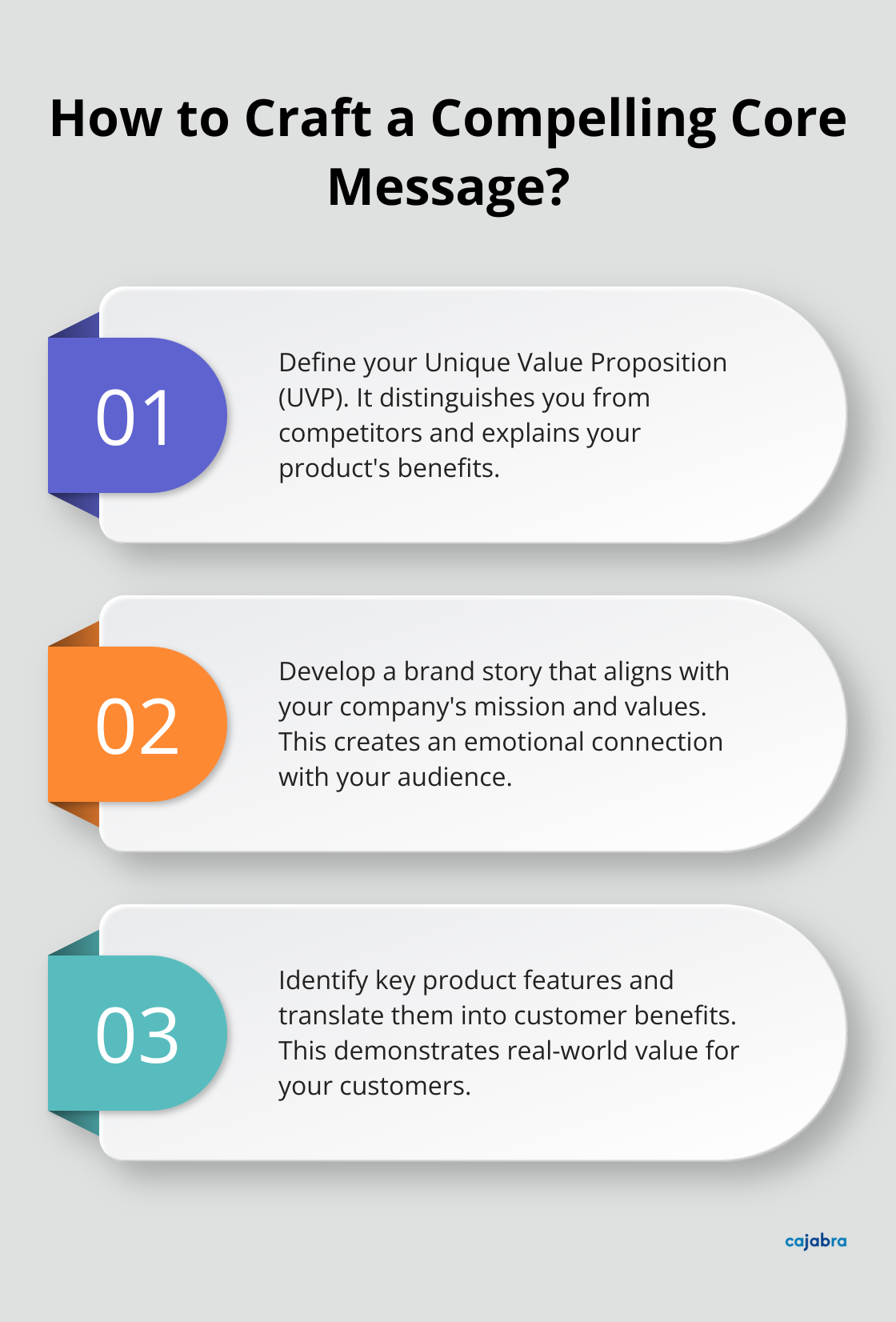
For accounting firms, a strong UVP might emphasize time-saving services and personalized financial guidance. For instance, a UVP could promise to transform accountants from overlooked to overbooked in 90 days by securing retainer-based clients. This clear, benefit-driven statement immediately communicates value to potential clients.
Develop Your Brand Story
Your brand story creates an emotional connection with your audience. Identify your company's mission and values, then craft a narrative that aligns your product or service with these principles and shows how you help customers achieve their goals.
If your accounting firm values innovation and personalized service, your brand story might highlight how you use cutting-edge AI technology to provide tailored financial advice. This approach showcases your capabilities and demonstrates your commitment to client success.
Identify Key Product Features and Benefits
While your UVP and brand story provide the emotional hook, you must also clearly communicate your product's tangible features and benefits. List all your product's features, then translate each feature into a benefit that directly addresses your audience's needs or solves their problems.
For example, if your accounting software includes automated reporting features, the benefit might read: "Save time on financial reporting, allowing you to focus on strategic business decisions." This approach clearly demonstrates how your product's features translate into real-world value for your customers.
Align Your Message with Customer Journey
Your core message should evolve as customers move through different stages of their journey. At the awareness stage, focus on addressing pain points and introducing your UVP. As potential customers move closer to a decision, provide more detailed information about features and benefits.
Test and Refine Your Message
Once you've crafted your core message, test its effectiveness. Conduct A/B testing on different versions of your message across various marketing channels. Pay attention to metrics like engagement rates, click-through rates, and conversion rates to gauge which messages resonate most with your audience.
Regularly revisit and refine your message based on customer feedback and market changes. This ensures your messaging strategy remains relevant and impactful in a dynamic business environment.
Now that you've crafted a compelling core message, it's time to put it into action. The next chapter will explore how to implement your messaging strategy effectively across different channels and touchpoints.
How to Put Your Messaging Strategy into Action
Select the Right Communication Channels
The first step in implementing your messaging strategy is to choose the most effective channels to reach your target audience. For accounting firms, this might include professional networking sites like LinkedIn, industry-specific forums, and email marketing campaigns. A recent study found that 72% of B2B content marketers reported an increase in LinkedIn usage, making it a prime channel for reaching decision-makers in the accounting industry.
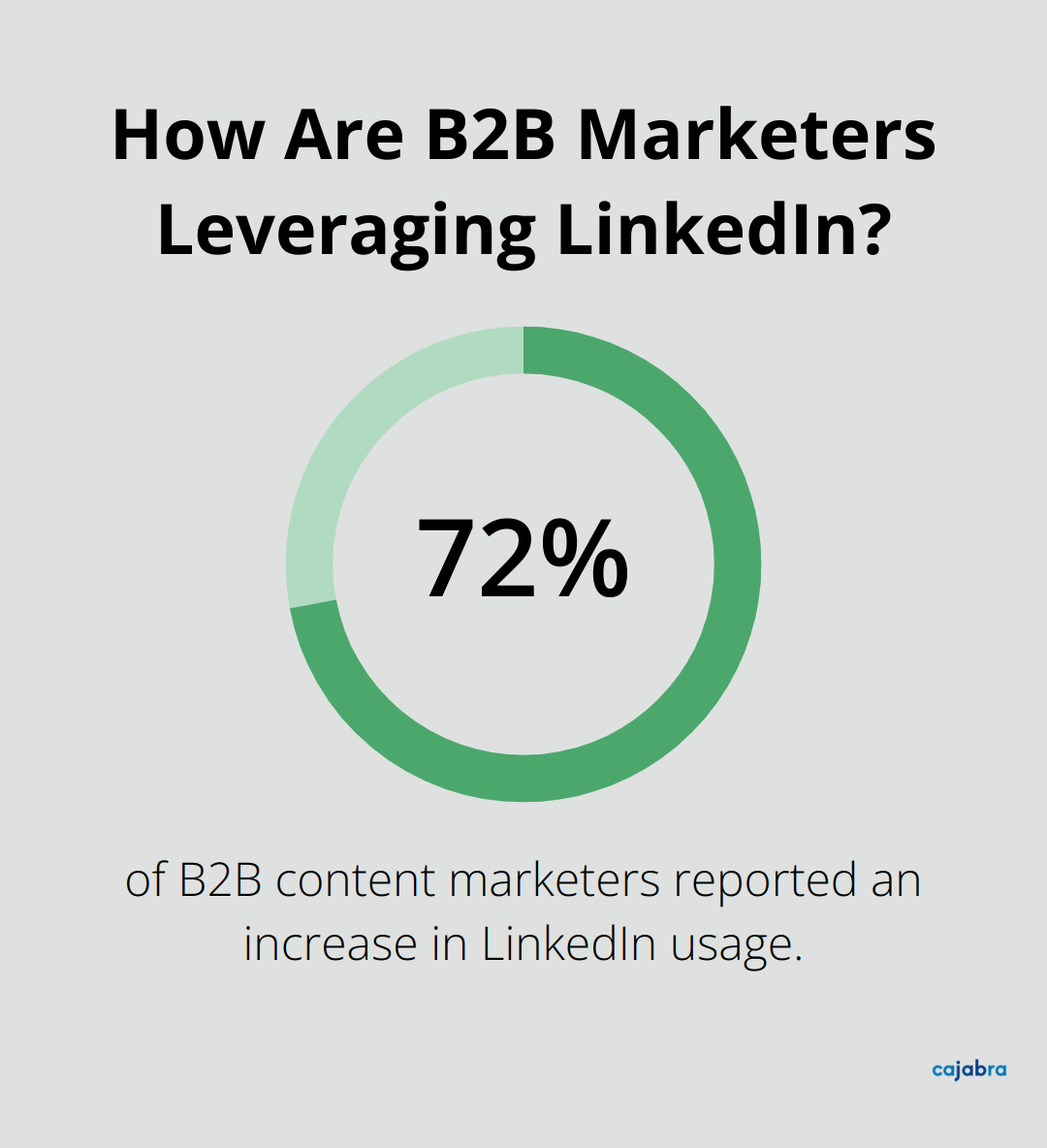
Don't limit yourself to digital channels. Traditional methods like speaking at industry conferences or publishing articles in trade publications can also effectively reach potential clients in the accounting sector.
Tailor Your Message Across the Buyer's Journey
Your messaging should evolve as potential clients move through different stages of their decision-making process. In the awareness stage, address pain points and introduce your unique value proposition. You might highlight how outsourced accounting services can save time and costs while ensuring accuracy for small business owners.
As prospects enter the consideration stage, provide more detailed information about your services and their benefits. Case studies and client testimonials can be particularly effective at this stage. You could share how your firm helped a manufacturing company reduce their tax liability by 15% through strategic financial planning.
In the decision stage, emphasize what sets you apart from competitors. This could include your specialized expertise, unique methodologies, or exceptional customer service. If you use the JAB System™ from Cajabra, highlight how it can help accountants secure retainer-based clients in just 90 days.
Test and Refine Your Messaging
Implementing your messaging strategy requires ongoing testing and refinement to maximize its impact. Use A/B testing to compare different versions of your message across various channels. Pay attention to metrics like engagement rates, click-through rates, and conversion rates to gauge which messages resonate most with your audience.
You might test two different email subject lines for a campaign promoting your business advisory services. The version that generates a higher open rate can then be used for future campaigns.
Don't forget to gather qualitative feedback as well. Conduct surveys or interviews with clients to understand how your messaging influenced their decision to work with you. This insight can be invaluable for refining your approach over time.
Maintain Consistency Across Touchpoints
While tailoring your message for different stages and channels is important, overall consistency is key. Ensure that your core value proposition and brand voice remain consistent whether a potential client encounters your message on your website, in a LinkedIn post, or during a face-to-face meeting.
This consistency helps build trust and reinforces your brand identity.
Leverage Technology for Efficient Implementation
Try to use marketing automation tools to streamline your messaging implementation. These tools can help you schedule content, personalize messages, and track performance across multiple channels. For example, you could use a customer relationship management (CRM) system to tailor your messaging based on a prospect's interaction history with your firm.
Additionally, consider using AI-powered tools for content creation and optimization. These can help you generate ideas for messaging variations and predict which versions are likely to perform best with your target audience.
Final Thoughts
A powerful product messaging strategy sets businesses apart in today's competitive market. Companies must understand their target audience, craft compelling core messages, and implement strategies effectively to enhance marketing efforts and drive growth. Continuous evaluation and adaptation ensure the strategy remains effective in a dynamic business environment.

We at Cajabra specialize in helping accounting firms develop and implement impactful product messaging strategies. Our JAB System™ transforms accountants from overlooked to overbooked in 90 days by securing retainer-based clients. We offer tailored solutions to help you communicate your value effectively to potential clients.
Take the first step towards a more effective product messaging strategy today. We have the tools and expertise to help you succeed, whether you want to modernize your online presence or maximize revenue from existing clients. Visit our website to learn more about how we can help transform your accounting firm's marketing approach.
At Cajabra, LLC, we've seen firsthand how accounting firms struggle with marketing in today's digital landscape. Traditional approaches often fall short, leaving accountants frustrated and overwhelmed.
Enter accounting market automation: a game-changer for firms looking to streamline their marketing efforts and attract ideal clients. This blog post explores how specialized strategies and cutting-edge technology can revolutionize your firm's marketing efficiency.
Why Generic Marketing Fails Accountants
The Pitfalls of One-Size-Fits-All Approaches
Accounting firms face unique marketing challenges that generic strategies cannot address. One-size-fits-all approaches often miss the mark, wasting time and money without yielding meaningful results. Positioning yourself as an authority in your field can attract clients seeking assistance in your specific niche. For example, a broad social media campaign might generate likes and shares, but it won't necessarily attract high-value clients seeking specialized financial expertise.
Tailored Strategies for Competitive Edge
In today's competitive landscape, accounting firms must adopt tailored marketing strategies to stand out. This approach involves focusing on niche markets, showcasing specialized expertise, and addressing the specific pain points of ideal clients.

Consider a firm specializing in tax services for small businesses. Their marketing efforts should create content and campaigns that directly address the tax challenges faced by small business owners. This targeted approach will resonate more strongly with potential clients and generate higher-quality leads.
Leveraging Industry-Specific Insights
Effective marketing for accounting firms requires a deep understanding of industry trends and client needs. Recent accounting literature focuses on emerging technologies' impacts on accountants' role and skills. This finding highlights the importance of showcasing specialized knowledge in marketing efforts.
The JAB System™ (developed by Cajabra, LLC) recognizes that generic marketing tools fall short in this specialized field. It focuses on securing retainer-based clients and optimizing online presence to position firms as industry leaders.
Measuring Success with Relevant Metrics
Generic marketing often relies on vanity metrics that don't translate to real business growth for accounting firms. Instead, firms should focus on metrics that directly impact their bottom line, such as:
-
Lead quality
-
Client retention rates
-
Revenue per client
The Power of Specialized Tools
To truly revolutionize marketing efficiency, accounting firms need specialized tools designed for their unique needs. Generic marketing platforms often lack the features and insights necessary to navigate the complexities of the accounting industry.
Specialized marketing tools (like those offered by Cajabra, LLC) can help firms:
- Automate lead generation processes
- Create targeted content that resonates with ideal clients
- Optimize their online presence for maximum visibility
As we move forward, it's clear that the future of accounting firm marketing lies in specialization and efficiency. The next section will explore how technology can further enhance these tailored marketing efforts, taking your firm's growth to new heights.
How Technology Boosts Marketing Efficiency for Accounting Firms
Automation Revolutionizes Marketing Processes
Technology transforms marketing strategies for accounting firms. Automated email campaigns, social media posts, and lead nurturing sequences maintain consistent communication with prospects and clients without constant manual effort. For example, a series of educational emails can automatically send to new leads, nurturing them towards a consultation.
A study by Emailmonday revealed that 63% of companies outsource all or part of marketing automation strategy planning, with 51% using a combination of outsourced and in-house resources. This trend underscores the growing importance of automation in maintaining a competitive edge.
AI-Powered Tools Enable Smarter Client Acquisition
Artificial Intelligence (AI) revolutionizes how accounting firms find and attract ideal clients. AI-powered tools analyze vast amounts of data to identify patterns and predict which prospects are most likely to convert. This allows for hyper-targeted marketing campaigns that speak directly to the needs of ideal clients.
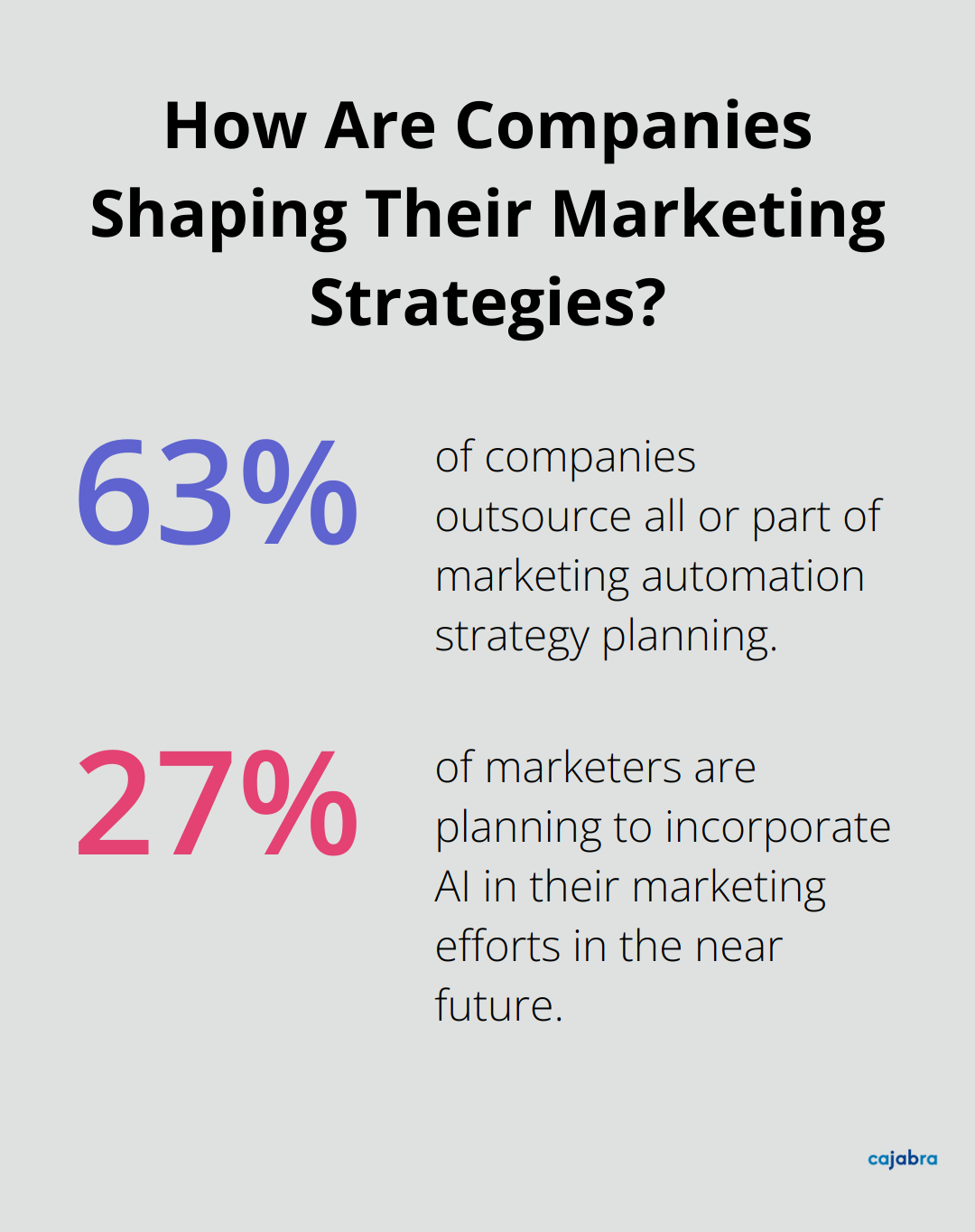
AI helps accounting firms:
- Analyze current client bases to identify common characteristics of most profitable clients
- Use predictive analytics to find similar prospects in target markets
- Personalize marketing messages based on individual prospect behaviors and preferences
A report by Salesforce indicates that 51% of marketers already use AI, with another 27% planning to incorporate it in the near future. This adoption rate highlights the technology's potential to drive marketing efficiency.
CRM Systems: The Cornerstone of Client Management and Retention
Customer Relationship Management (CRM) systems prove essential for accounting firms aiming to improve client management and retention. A good CRM system allows firms to:
- Track all interactions with clients and prospects
- Segment client bases for targeted marketing efforts
- Set reminders for follow-ups and important deadlines
- Analyze client data to identify upselling and cross-selling opportunities
Research by Nucleus Research found that CRM pays back $8.71 for every dollar spent. This impressive ROI demonstrates the power of CRM systems in driving business growth.
When selecting a CRM system, accounting firms should look for one that integrates with existing accounting software and offers features specifically designed for professional services firms. While many options exist, specialized tools (like those offered by Cajabra, LLC) provide unparalleled benefits for accounting firms, as they're tailored to the unique needs of the industry.
These technological advancements significantly boost marketing efficiency for accounting firms. From automating routine tasks to using AI for smarter targeting, and implementing robust CRM systems, these tools allow firms to focus on their core competency – providing expert financial services to clients. The next chapter will explore how accounting firms can build a strong online presence to complement these technological strategies and further enhance their marketing efforts.
How Accountants Build a Powerful Online Presence
Create a Website That Converts
Your website often serves as the first point of contact between your firm and potential clients. It must make a stellar first impression. Attract more clients to your accounting website and increase revenue with top user experience design tips (UX) for accounting and financial professionals.
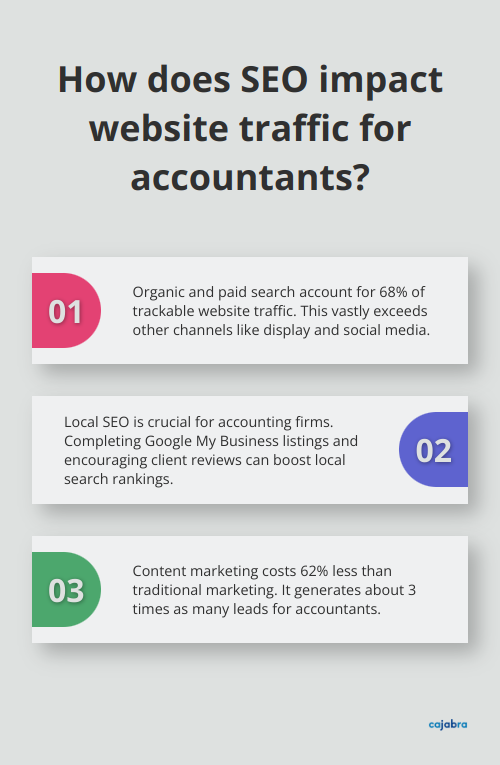
A high-converting accounting website looks clean, easy to navigate, and clearly communicates your unique value proposition. Include client testimonials, case studies, and a clear call-to-action on every page. Display your contact information prominently and consider adding a chatbot for instant engagement.
Page load speed is critical. Optimize your images, leverage browser caching, and consider using a content delivery network (CDN) to speed up your site.
Dominate Search Results
A great website is only half the battle. You need to ensure potential clients can find you online. This is where search engine optimization (SEO) comes into play. A study by BrightEdge found that 68% of all trackable website traffic is sourced from organic traffic and Paid Search, vastly exceeding all other channels, including Display and Social Media.
Start by identifying keywords your ideal clients search for. Once you have your keywords, incorporate them naturally into your website content, meta descriptions, and page titles.
Local SEO is particularly important for accounting firms. Ensure your Google My Business listing is complete and up-to-date. Encourage satisfied clients to leave reviews, as these can significantly boost your local search rankings.
Use Content as Your Secret Weapon
Content marketing is a powerful tool for showcasing your expertise and attracting ideal clients. According to the Content Marketing Institute, content marketing costs 62% less than traditional marketing and generates about 3 times as many leads.
Accountants should create content that addresses the pain points and questions of their ideal clients. This could include blog posts about tax-saving strategies, videos explaining complex financial concepts, or infographics breaking down industry trends.
Consistency is key. A content calendar can help you plan and publish regularly. Try to create a mix of evergreen content (always relevant) and timely pieces (addressing current events or changes in tax laws).
Promote your content effectively. Share it on social media, include it in your email newsletters, and consider guest posting on relevant industry websites to expand your reach.
Leverage Specialized Marketing Services
Building a strong online presence takes time and effort, but the payoff is substantial. It positions your firm as a trusted authority, attracts ideal clients, and sets the stage for long-term growth. While many firms struggle with this aspect of marketing, specialized services (like those offered by Cajabra, LLC) can streamline the process, allowing you to focus on what you do best – serving your clients.
Final Thoughts
Efficient marketing for accounting firms requires a specialized approach tailored to the unique challenges of the industry. Generic strategies fall short in today's competitive landscape. Accounting market automation emerges as a game-changer, streamlining processes and freeing up valuable time for accountants to focus on their core expertise.

A strong online presence proves essential for modern accounting firms. A professional, user-friendly website serves as the cornerstone of digital marketing efforts. Strategic SEO and content marketing position firms as trusted authorities in their field.
Accountants who want to embrace these modern marketing techniques can benefit from specialized services. Cajabra, LLC offers a comprehensive solution designed specifically for accounting firms. Their JAB System™ and suite of marketing tools help firms secure retainer-based clients and optimize their online presence.
